Den of Geek

Star Trek: The 50 Best Alien Races
From Tribble to Andorians, we're ranking the 50 best alien life forms explored in the Star Trek universe...
- Share on Facebook (opens in a new tab)
- Share on Twitter (opens in a new tab)
- Share on Linkedin (opens in a new tab)
- Share on email (opens in a new tab)
The crews of the various iterations of Star Trek boldly went where no one has gone before — and then boldly met a crap ton of alien species.
Star Trek may be the human adventure, but there have been countless non-human beings, critters, menaces, gods, and blobs that have been introduced in the Star Trek universe. From The Original Series to The Animated Series , to The Next Generation , to Deep Space Nine , the Delta Quadrant and Voyager , to the early adventures of Enterprise , to the modern day films, Star Trek has gifted fans with unforgettable species after species as the five-year mission has turned into five decades of first contact.
There have been vile races bred for combat, omnipotent races that use humankind as puppets, and even a bunch of cute little furry things. Star Trek just keeps on delivering the cool aliens show after show, film after film. Just imagine the species that will soon be coming to Star Trek: Discovery ! But now is the time to celebrate the past as we present the fifty coolest Star Trek aliens ever to appear in films or TV.
50. Arcturian
First appearance: star trek: the motion picture (1979).
The Arcturian didn’t have a great deal of Star Trek screen time, but this alien race that resembled melted wax (eww) makes our list because it stands as a prime example of the story richness of the Star Trek galaxy. An Arcturian can briefly be seen in Star Trek: The Motion Picture and the Mego toy company even made two versions of this blink and you’ll miss him creature (one 3 ¾ inch one 12 inch). But what intrigues us the most is this melty guy’s backstory…
Ad – content continues below
Star Trek costume crafters extraordinaire Fred Phillips and Robert Fletcher came up with a rich history for the Arcturian. According to Philips and Fletcher, the Arcturians were actually a race of clones that made up the bulk of the Federation’s infantry. While never seen on screen, there are legions of these guys running around, just waiting to be sent to some hostile planet to go to war. The Federation has always been portrayed as peaceful and benevolent, but it has the potential to unleash billions of melty looking monsters at a moment’s notice. Yikes.
Arcturians also appeared in the Star Trek daily comic strip and their back story continues to stand as a great example of the vast richness of the Star Trek galaxy, a place where billions of stories exist at all times. Including one about a race of wax soldiers that can be replicated and sent to do the Federation’s will. Eeep.
49. Edosian
First appearance: star trek: the animated series “beyond the farthest star” (1973).
Edosians are a tripedal species and are skilled at using their three arms and three legs in navigation and piloting. Lieutenant Arex, the loyal Enterprise navigator that first appeared in Star Trek: The Animated Series , is a proud member of the Edosian species and was a recurring character during this era of animated Trek. Arex was voiced by Scotty himself James Doohan and was a standout character in the era between The Original Series and The Next Generation .
Arex popped up in comics and novels and took his place of honor among the original crew. Arex also was a character that fully utilized animation as the six limbs and distinct alien features of this character would have been impossible to pull off in live-action back in the day. But thanks to The Animated Series , the distinctive Edosians live on and prosper in Trek lore.
48. Excalbians
First appearance: star trek: the original series “the savage curtain” (1969).
Listen, any species responsible for bringing Abraham Lincoln into the Star Trek universe has to make this list. The Excalbians are a silicon based life form that possessed the ability to shape shift. These rock beings, who honestly looked like something Steve Ditko would have designed for Doctor Strange, were fascinated by the human notion of good and evil.
So they did what anyone would do in the same situation: they made a recreation of Abraham Lincoln and teamed it with Kirk, Spock, and famous Vulcan goodie-good Surak and sent them up against four representatives of evil — Kahless the Unforgettable of Qo’noS, Genghis Khan, Colonel Green of Earth and Dr. Zora of Tiburon. How’s that for a traditional Survivor Series match?
For this wonderful bit of schlock and for making us believe that Ben Grimm could work in live action in 1969, we salute the ever curious Excalbians.
Get the best of Den of Geek delivered right to your inbox!
47. Caitian
First appearance: star trek: the animated series “the survivor” (1973).
The cat-like Caitians were represented in Enterprise history by M’Ress, a feline female that served both as engineer and a communications officer during The Animated Series . M’Ress spoke in a purring voice and was a skilled operative that stood side by side with the more iconic members of the Enterprise.
Now, I would like to talk about how cool the Caitians were. I would like to talk about how M’Ress was the main character in the Power Records’ Star Trek book and record set Star Trek: Passage to Moauv (1975). I would also like to talk about how a Caitian also appeared in Star Trek IV: The Voyage Home …
But I just can’t help but wonder if Captain Kirk did what he does and somehow at some point bed down with this cat woman. This would make Kirk’s TV sci-fi’s first furry and I’m sort of fascinated by this idea. I don’t want to focus on this idea because it kind of reduces M’ress as a character and the Caitian as a race… But then I read that the alien twins that Kirk hooked up with in the first Abramsverse film were confirmed to be Caitian and everything just stirs up again and I fell absolved of all responsibility.
Anyway, M‘Ress and the Caitians might be considered obscure now, but she was a pretty big deal to Trek lore during The Animated Series era. So this race is a purr-fect addition to our list. Did the Enterprise come equipped with a giant litter box? Okay, I need to stop now; this is going to some bad places.
46. Bolians
First appearance: star trek: the next generation (1988).
The Bolians have been a perennial background species since their first Trek appearance in 1988. The first Bolian fans witnesses aboard the Enterprise was an ambassador, but many other Bolians have appeared around the Trek verse since. They have been seen as barbers, manicurists, Federation troops, and high ranking officials.
Bolians are distinctive due to their blue skin and their ridge that bisects their anatomy. They are highly friendly individuals and compassionate. In fact, an episode of Voyager puts forth that Bolians were supportive of assisted suicide. These deep seated beliefs make the Bolians an intriguing species ripe for future Trek exploration.
45. Lurian
First appearance: star trek: deep space nine “the emissary” (1993).
Lurians were a very rarely encountered species that possessed multiple hearts, lungs, and stomachs. Fans got to know this ellusive species through DS9 regular/bar fly Morn. Yes, Morn is an anagram for Norm, because, like the famed Cheers fat man, in Quark’s Bar, everyone knew Morn’s name.
Morn was a bombastic and talkative fellow who fans never got to actually hear speak. He was a former thief that barely moved away from his bar stool. Morn was also fiercely loyal to Quark and got his little Ferengi pal out of many a jam. But mostly, Morn just sat there and drank stoically.
Although we only ever met one Lurian, we will always remember his name because Morn was such a constant (and inebriated) presence on Deep Space Nine . He also once had a torrid love affair with Jadzia Dax but that is a tale for another time. Raise a glass to the Lurians!
First appearance: Star Trek (2009)
So far, the rebooted Trek films have not really given funs much by way of alien species. The only classic races to get good screen time in the reboots have been Romulans and Vulcans. But the films did give us Keenser the Roylan, Scotty’s diminutive engineering pal.
Keenser first appeared in the first Trek reboot film as Scotty’s ever present companion when Scotty was exiled on the Federation outpost on Delta Vega. When Scotty beamed to the Enterprise, he left Keenser behind which was kinda sad. JJ Abrams and company must have thought so too as Keenser was all of a sudden part of the Enterprise’s crew in Star Trek: Into Darkness .
Keensar is ever loyal to his pal Scotty as the two share one of the best bromances in the galaxy. The fourteenth issue of IDW Publishing’s Star Trek comic gifted fans with Keensar’s origin. It also revealed the name of his species — Roylan — for the first time.
In this issue, fans learned that Keensar was constantly mocked by his peers because he was so tall (heh). It also revealed that Keensar served with distinction aboard the USS Kelvin and was shipmates with none other than George Kirk.
Keensar the Roylan is a constant presence in the new Trek Universe and I’m sure this member of the Roylan species will have many adventures to come.
43. Mugato
First appearance: star trek: the original series “a private little war” (1968).
Because sometimes in space, there are giant, poisonous horned gorillas. What’s not to love about Mugato? He’s kind of cute, very fuzzy, and is as poisonous as the nastiest snake. Poisonous gorillas in space, this is why we love Trek. Sadly, Mugato only appeared briefly, attacking and poisoning Kirk before being disintegrated by Doctor McCoy.
But, remember: as you watch the hard sci-fi and techno jargon of Trek, as you witness the human adventure of Roddenberry’s galaxy, as you watch carbon-based life forms achieve full potential and enlightenment, remember , in this same world there are fuzzy, horned, albino gorillas that will poison the crap out of you.
42. Acamarians
First appearance: star trek: the next generation “the vengeance factor” (1989).
The Acamarians are an advanced race of humanoids that have found a peaceful existence very late in its history. For centuries, the tattooed Acamarians lived in rival clans and their planet was split apart by warfare. One of the clan wars lasted three centuries and wiped one of the combating sides out of existence. When Picard’s Enterprise encountered the Acamarians, the people finally almost found peace.
However, a splinter group known as the Gatherers could not overcome centuries of clan warfare and refused to negotiate, so Picard had to navigate the complex web of Acamarians politics and bitterness as well as the assassination of the Gatherer ambassador to finally forge a peace with the Acamarians.
Despite all these issues, the Acamarians have a rich culture and mirror many contemporary Earth societies that have been splintered by war. Sci-fi works best when it reflects reality, and through the Acamarians, Trek fans got to see some really effective social commentary about tribalism and societal bitterness.
41. Denobulans
First appearance: enterprise “broken bow” (2001).
A Denobulan served aboard the very first Enterprise as the ship’s doctor, thus making the species vital to the origins of the Federation. Our medic in question, Phlox by name, was one of the main protagonists in Enterprise and was a staunch example of the exemplary qualities of the Denobulan race.
Denobulans are loyal but quite hedonistic by human standards. Denobulan males can take up to three wives while the entire race embraces polyamory. As humanity headed off into space aboard the first Enterprise, Phlox served as a constant reminder of the varied belief systems and practices the people of Earth would encounter as space exploration began.
Phlox and the Denobulan held ethics in high regard as Phlox would never allow a sentient being to suffer. Even though the ridge faced Denobulans had fierce tempers, they also were gentle and kind, and valued knowledge and pleasure over confrontation and violence.
Denobulans also have the propensity to puff out their faces when they were threatened — so, yeah, there’s that. Plus, Denobulans have really long tongues. What was it that I said about hedonism and Denobulans? Anyway, these cunning linguists were great doctors as seen through Enterprise ’s first mayor of the sickbay: Doctor Phlox.
Hit the next page for more!
40. Orions
First appearance: star trek: the original series “the cage” (1966).
The green Orion slave dancer that shimmied into the dreams of Trek fans has been an iconic bit of Star Trek lore since her Shakiraesque debut, but the history of the Orions did not stop there…
Although a cosplay staple, the slave girl was just one Orion. Others have appeared in The Animated Series , Enterprise , novels, comics, toys, and one even prominently appeared in the J.J. Abrams Star Trek timeline as Uhura’s roommate and an early romantic partner of one James T. Kirk.
Orions are a species with close ties to the Federation — ties that are explored in some of the better episodes of Enterprise . Although the Orions will long be remembered because of the grinding of the hips of a slave dancer, there is so much more to this green-skinned humanoid species that has been part of Star Trek lore since almost day one.
39. Ocampans
First appearance star trek: voyager “caretaker part ii” (1995).
The Ocampans carry an importance to the Star Trek universe because Kes, a noted member of the Ocampan species, was a member of the lost Voyager crew for three years. Ocampans are a race with powerful telekinetic powers but, sadly, this race of elf-like humanoids only have a life span of nine years. (So… combine Jean Grey with a mayfly and you get the idea.)
Ocampans are very accepting of their short life span and a rather enlightened species. Through Kes, the crew of Voyager learned a lust for life as the wide eyed Ocampan enjoyed every minute of her existance even though she was trapped with the Voyager crew. When Kes’ power grew out of control, she left Voyager and her friends, including her constant companion Neelix, and used her abilities to push the lost Voyager out of Borg space and a year closer to home. This sacrifice taught the crew of the Voyager and fans of the show the innate nobility of the Ocampan race.
38. Vidiians
First appearance star trek voyager “the phage” (1995).
While the Ocampans were a nice, little, Tinkerbell-like species that fluttered about Voyager , there were also these Wes Craven nightmares… The Vidiians suffered a disease known as the Phage. The Phage is kind of like a hardcore space Ebola that utterly destroys the infected’s body and organs. So, yeah, Bones McCoy was sort of right about space being a petri dish of death and pain.
The ravaged Phage would wander the galaxy and rob sentients of their organs and body parts. So there you are, doing warp three with caution around the Delta Quadrant, and, all of a sudden, a few Vidiians beam unto your ship and rip out your liver and intestines. Then, they use said liver and intestines to replace their own — whether you filled out your Federation organ donor cards or not.
The Vidiians were eventually cured by the crew of the Voyager, but you have to assume that in a galaxy so big there are still some Vidiians cruising around out there taking hearts and lungs from innocent travelers. Yeesh.
37. Breen
First appearance: star trek deep space nine “indiscretion” (1995).
First off, cool points for the Breen because the helmet that this species wears looks kind of like the helmet Princess Leia used to disguise herself as a bounty hunter in Return of the Jedi . But the space awesomeness of the Breen doesn’t end there…
The Breen’s fighting prowess and technology are so advanced that even the Romulons and Klingon talk about this mysterious species in hushed whispers. And, indeed, when the Breen made themselves known to the Federation during the Dominion War, things got intense. These mighty warriors allied themselves with the Cardassians and the Dominion to take on the combined might of the Federation, the Klingons, and the Romulons.
During this conflict, the Breen destroyed the USS Defiant, the flagship of the Deep Space Nine space station, and managed to attack the Earth city of San Francisco. The Federation managed to develop counter weaponry to defeat the Breen, but many will remember these armored badassess as race of military specialists to be reckoned with.
The alliance with the Dominion cost the Breen, though, and — after the War — it wasn’t easy being Breen.
36. Hunters
First appearance star trek deep space nine : “captive pursuit” (1993).
Imagine a Trek alien that is pretty much Boba Fett mixed with Kraven the Hunter and you have these big game-tracking motherfuckers. The Hunters popped out of the Bajoran Wormhole and had their first contact with the Federation in the DS9 episode “Captive Pursuit.” In this stirring installment of this reporter’s favorite Trek show, fans were introduced to the Hunters and their chosen prey: the genetically enhanced Tosk.
The Hunters (whether this was the species name is unknown) would alter their Tosk prey in order to make the hunt more difficult. The pursuing of the Tosk was an obsession with the Hunters that rubbed members of the freedom loving Federation the wrong way.
The Hunters even gave the Federation a run for its money as the race of killers had advanced tech to assist them in their eternal hunt for Tosk. Sadly, the Hunters only appeared in one episode of Deep Space Nine , but their fighting skills and bloodthirsty rituals will be burned into the minds of Trek fans for a long time.
35. The Salt Vampire
First appearance: star trek: the original series “the man trap” (1966).
Old Salty here, or creature M-113, is a reminder that space can be a really, really dangerous place because there are things out there called Salt Vampires. And, no, this thing doesn’t just hang around a Pringles factory, it freakin’ shape shifts and then kills innocent people and drains them of their salt. Kirk and his crew first encountered this thing as it took the form of a number of the Enterprise’s crew. It almost killed Sulu, Yeoman Rand, Spock, and Kirk before being shot and killed by Dr. McCoy who had no time for such foolishness.
I suppose Kirk could have kept the Salt Vampire alive and just fed it Wetzel’s Pretzels (those things are like licking the ocean), but I guess Kirk felt that a shape shifting thing that looks like it was spat out of the ninth plane of hell that brutally kills people and drains them of sodium probably needed to be deleted from the universe. One has to wonder what special M-114 might be: Cinnamon Vampire?
34. Cheron
First appearance star trek: the original series “let that be your last battlefield” (1969).
When we first met the Cheron, there was only two members of this species left: Bele (played by the Riddler himself, the great Frank Gorshin) and Lokai. Bele was hunting Lokai whom Bele deemed a traitor after the planet Cheron was wiped out due to centuries of racial wars.
Apparently, some Cheron were black on the left and white on the right while other members of this advanced species possessed the opposite skin alignment. Due to this difference, the entire population — save Lokai and Bele — were eradicated. Bele hijacked the Enterprise and used his vast array of mental capabilities to hunt for Lokai.
The whole opposite was a thinly veiled, but powerful allusion to the destructive potential and sheer idiocy of racism — a message as powerful today as it was in the ’60s. Of course, you know I’m going to say that Mego made a Cheron doll, a toy I treasured in my childhood and called Oreo Man.
We should all have an Oreo Man during our most innocent years. But who knew my beloved Oreo Man was actually a genocidal racist madman that used his vast power to almost destroy the Enterprise? Oh, Oreo Man…
33. Nausicaans
First appearance: star trek: the next generation “tapestry” (1993).
One of the surlier races in the galaxy, Nausicaans are big hairy warriors that hire themselves out as mercenaries throughout the galaxy. A Nausicaan had quite the impact on the life of Jean-Luc Picard. When the future captain of the Enterprise was an ensign, he played a stirring game of domjot with some Nausicaan thugs (as one does). Picard and his pals accused the Nausicaans of cheating and the bad-tempered badasses stabbed Picard through the heart. This required Picard to get an artificial heart. (The more you know!)
The Nausicaans gave the crew of Deep Space Nine a hard time as well. This hairy race of pirates even encountered Captain Archer and the original crew of the Enterprise back in the day, proving that big hairy thugs that cheat at domjot remain big hairy thugs that cheat at domjot.
All that aside, Nausicaan fighting prowess is equal to the fighting prowess of Klingons and the only thing that keeps the Nausicaans from being more of a threat is their mistrust and their inability to come together as a species. Instead of being intergalactic conquerors, the Nausicaans have remained bullies, raider, and cheaters. But they do have killer 80s rocker hair, don’t they?
32. Kazon
First appearance: star trek: voyager “caretaker” (1995).
The Kazon were the first race that the crew of the Voyager encountered when they arrived in the Delta Quadrant, and — as far as d-bag, aggressive alien species go — the Kazon take the space cake (because when you put the word space in front of something, it sounds like you are in the future).
The Kazon race was separated into rival sects, which made negotiating with them as a whole almost impossible. They were once a slave race that served the Trabe, but the Kazon were a fractured species before and during its enslavement. Despite their disloyalty to each other, the Kazon were fierce combatants who were unwilling to negotiate a peace treaty with the Trabe or Voyager.
The Kazon had advanced technology and a back-stabbing blood thirst that introduced the crew of the Voyager to the Delta Quadrant and caused Voyager to be trapped in what was going to be a very hostile place, if the battle-hardened Kazon were any indication.
31. Metrons
First appearance: star trek: the original series “arena” (1967).
We do so love the Gorn. And what alien species was responsible for Kirk’s immortal battle with the Gorn? Why that would be the shiny and nigh omnipotent Metrons.
The Metrons possess tremendous mental powers and can control matter and energy. These human like aliens fiercely guard their sector of space and regard even the most minor intrusion as a great trespass punishable by death. When the Enterprise and a Gorn vessel find themselves in Metron space, the Metrons mentally teleport both Captains to a remote planet and force them to fight.
The Metrons are intensely xenophobic and regard other races as barbaric, so when Kirk spares the Gorn, the aloof Metrons are impressed and free both vessels. You see, a simple act of kindness was all it took to free the Enterprise from the Metrons’ wrath and impress a race of people that do not impress easily. Also, the Metrons wear sparkly evening gowns so they have that going for them…
30. Horta
First appearance: star trek: the original series “devil in the dark” (1967).
The Horta may look like a pile of bile soaked dog puke, but, hey, it was featured in William Shatner’s favorite Star Trek episode, so we have to give this blob of silicon its props.
The Horta was first encountered by a group of miners. After a miner was killed, Kirk and company were called to see what was up. They encounter the Horta, an extremely alien-looking beastie. After the creature is injured, Spock attempts a mind meld but the creature is in too much pain for Spock to connect with it. Soon, the crew of the Enterprise learns that the creature is the lone survivor of its race charged with protecting the eggs of the next generation of Horta. So Kirk and his pals dedicate themselves to protecting the thing’s little vomit eggs from the angry miners.
All jokes aside, the Horta was classic Trek alien: a semi-cheesy-looking beastie that stars in an episode with a powerful theme. The Horta was a prime example that all life has merit and even something that looks like a half-digested taco only wants to survive and thrive. By saving the Horta, the crew of the Enterprise shows that their most important mission is to contact and understand all life, no matter what it looks like. Thank you for that valuable lesson, Mr. Horta.
29. Greek Gods
First appearance: star trek: the original series “who mourns for adonis” (1967).
Wait, what? Oh, by the bristling beard of Zeus, the Greek Gods exists in the Star Trek universe.
The legendary deities of ancient Greece were actually super-powered aliens that lived on Pollox IV. They would visit Earth back in ancient times and bask in the worship of primitive humans. Well, the humans of the Enterprise were no primitives, and — when the Pollox IV alien that called itself Apollo trapped Kirk and his crew on the planet and refused to allow them to leave — Kirk and Spock fought back, kicking a god’s ass in the process.
Sadly, we never saw the other Greek gods. (Because could you just imagine Kirk versus Zeus?) But, it was established the other gods existed — and that they wore togas and laurel leaves like they were going to a frat party. The fact that this all exists in the same galaxy as Klingons and Borg just makes me very happy.
28. Hirogen
First appearance: star trek: voyager “message in a bottle” (1998).
The Hirogen are a nasty Delta Quadrant species of reptilian hunters that view any other sentient beings as prey. When the Hirogen chose a victim, the religious ritual of the Hunt began and all aspect of Hirogen culture centered on this blood sport. After the Hirogen tracked and captured its prey, they would remove the victim’s skeletal system, muscles, internal organs, ligaments, and tendons and keep these parts as trophies.
The Hirogen ran afoul of the Starship Voyager a number of times and Captain Janeway and her elite crew always found ways to defeat these hunters. In one of the Hirogen’s more bone headed moves, they created advanced holograms that could feel fear and pain. These thinking holograms quickly became more advanced than the Hirogen and turned the hunters into the hunted.
Despite this addlepated move, the Hirogen were always a feared species for those that traveled through the Delta Quadrant because they were essentially Predators dropped into the middle of the Star Trek universe.
27. El-Aurians
First appearance: star trek: the next generation “the child” (1988).
El-Aurian were a race of wise and peaceful people that transverse the galaxy to listen to the stories of others. When the Borg wiped out the El-Aurian’s home world, the galaxy lost a race of wise listeners… Or it almost did, because the surviving members of this race spread out across the galaxy.
Fans met the El-Aurians when The Next Generation introduced Guinan, the proprietor of Ten Forward, the bar of choice for the crew of the Enterprise. When Guinan came aboard, the members of the Enterprise had a kind and quick-witted being to bounce their problems off of, and Guinan listened. It was a shame that so many people like Guinan were lost to the Borg as the El-Aurians long lived goodness was a boon to the galaxy.
But not all El-Aurians were benevolent. Tollan Soran was an El-Aurian survivor that was aboard a ship of refugees with Guinan when the ships ferrying the El-Aurians refugees was lost to the fiery Nexus ribbon. It seemed that the legendary Captain Kirk was killed in this rescue attempt, but it turns out Kirk was trapped within the Nexus.
Soran became obsessed with returning to the Nexus and his Ahab like need for knowledge led to the first and only meeting between James T. Kirk and Jean Luc Picard. Soran was an anomaly to the El-Aurians species as most of the race used their centuries of wisdom to spread enlightenment wherever they went.
26. Tellarites
First appearance: star trek: the original series “journey to babel” (1967).
Along with Andorians and Vulcans, Tellarites were one of the first species to join the United Federation of Planets. A Tellarite first appeared in The Original Series episode “Journey to Babel,” where Sarek, Spock’s father, was framed for the murder of a Tellarite ambassador.
Sarek was able to solve the crime, freeing his name and forging a long-lasting peace with the Tellarities. Early contact with the Tellarites was recounted in Enterprise , but members of the specials also popped up in The Next Generation and even in a couple of films. Tellarites, with their distinctive beards, hooves, and stubbornness, have long been one of the backbone species of the Federation.
25. Tamarians
First appearance star trek: the next generation “darmok” (1991).
“Temba, his arms wide. Shaka, when the walks fell.” Who can forget these poetic, yet somewhat ominous phrases spoken by Dathon the Tamarian to Captain Picard when the two were trapped on a hostile world together?
Trek lore has it that the Federation and the Tamarians only had seven encounters over the years because the Tamarian language was so hard to comprehend. Well, if he was to survive, Picard would have to understand it (and fast) because Dathon beamed Picard down to the planet in order to teach the human captain a language that was as complex as it was beautiful.
It turns out Tamarians only communicate in metaphors (I’ve had grad school professors like that), and in order for the Federation and the Tamarians to build an accord, Picard would need to understand those metaphors. “Shaka when the walls fell,” has become quite a famous little moment of Trek myth as the Tamarians stand as a metaphor themselves — for cultural understanding and empathy.
24. Species 8472
First appearance: “star trek: voyager” part 1 (1997).
Species 8472 are so deadly that they even make the Borg poop their cybernetic underroos. (Hey, do you think when the Borg poops they all go at once? Or does one go make while the rest of the Collective just snickers? This is now the most ever written about Borg poop on the internet. Or is it? I’m not googling that.)
Anyway, Species 8472 existed in an extra-dimensional bit of hell known as fluidic space. When the Borg discovered the fluidic dimension, the ever deadly race of cybernetic killers busted through the dimensions and attempted to assimilate Species 8472. 8472 was having none of that and fought back, creating weapons that could slay the Borg with ease. In fact, 8472 was able to destroy the Borg Cubes in seconds. (Man, that’s like taking down the Death Star with a single bullet.) Sadly, Species 8472 also took out many innocent Delta Quadrant planets, which forced the crew of Voyager to get involved.
The Borg and Voyager had to form an unlikely alliance to drive Species 8472 back to fluidic space. 8472 was one of the closet things Trek fans ever got to Lovecraft-like cosmic horrors, as even the Borg could not stand up to these waling nightmares. This species appeared a few more times on Voyager until Captain Janeway was able to broker a peace with these terrors that exist behind the fabric of time and space.
23. The Gorn
Oh, the Gorn. Who doesn’t love Gorn? Of course, this rubbery looking and cold blooded reptilian monstrosity first appeared in the classic TOS episode “Arena,” where Kirk had to go mano-e-lizardo with the captain of a captured Gorn vessel. What followed was one of the most classic fights in Trek history as Kirk had to fashion a makeshift cannon to defeat this alien monster.
Despite its primitive appearance, future novels established the Gorn as a technologically-advanced race and, you just have to admit, Trek lore has not even scratched the surface of the Gorn. Imagine the spin offs. The Gorn Identity. Gorn to be Wild. Gorn on the Fourth of July. Fans were able to witness the Gorn home world for the first time in DC Comics’ Star Trek the Next Generation: The Gorn Crisis .
The Gorn were also one of the aliens made by Mego in its second set of Trek dolls. Fun fact: Mego’s Gorn looks nothing like the TV Gorn, as Mego just reused Marvel’s Lizard mold, painted it brown and decked old Gorny in the outfit used for the Klingon doll. Despite this lack of toy respect, and despite one of the cheapest prosthetic heads ever seen on TV, the Gorn’s battle with Kirk is still forever burned into Trek lore.
22. Tholians
First appearance: star trek: the original series “the tholian web” (1968).
Get a load of these psychedelic xenophobes. Yeah, the Tholians might look like a funky black light album cover come to life, but, really, they are brutal, territorial, hateful, and will do anything to keep other species out of Tholian territory. But, hey, they are known for the punctuality, so take heart in the fact that, when they kill you, it’ll be done in a timely fashion.
The Tholians cruise around their sector of space in geometric rainbow ships, making the aesthetic of the race more Yes album cover and less cool space despots. The Tholians first encountered the crew of the Enterprise when the USS Defiant flew too close to Tholian space.
Always protective of their borders, the Tholians phased the Defiant out of real space and into an interspace dimension. Kirk himself was phased out of time and space (for Shatner, it wouldn’t be the first or last time this happened), but Spock and the Enterprise were able to get their captain back and pimp-slap the Tholians.
The Enterprise under Jonathan Archer also ran afoul of these crystalline killers. The Tholians are a great example that in space, threats can come in any shape and even rainbows can kill you.
21. Talaxians
First appearance: star trek: voyager “caretaker” (1995).
One of the friendlier species of the Delta Quadrant, the Talaxians — or more accurately, an individual member of the Talaxian species — was pivotal to Voyager’s survival during the years it spent trapped in the Delta Quadrant.
Talaxians became dispersed throughout the Delta Quadrant after a devastating war with the Haakonian Order. Talaxians had no real home world, but that did not break their spirits. Talaxians are a very spiritual, upbeat, and whimsical race that — when confronted with two unpleasant paths to take in life — will find a third, happier path to traverse. This spiritual ability to find light and hope in any circumstance made the Talaxian Neelix indispensable to the crew of the Voyager.
Neelix was the cook and morale officer aboard Voyager and helped his friends out of many spiritual and literal crises. Throughout its wanderings in the Delta Quadrant, Voyager encountered many Talaxians that were always willing to lend a hand. Sadly, many aggressive species like the Borg also targeted the peaceful Talaxians — but, like Neelix, the Talaxians always found that third path.
Keep going, because we’ve got more aliens for you!
20. Organians
First appearance: star trek: the original series “errand of mercy” (1967).
When Kirk, Spock, and the crew of the Enterprise first encounter the Organians, a non-distinct humanoid species, this new race appeared to be akin to an 18th century agrarian Earth society. Spock commented that his tricoder has more technology than the entirety of the Organians planet.
Sadly, the Organians home world became caught up in a war between the Federation and the Klingons. Kirk warned the Organians leaders that war was coming but the Organians were completely unconcerned… When the Klingons arrived and began to take Organians hostages, the Organians remained unconcerned — because, apparently, the Organians are millions of years more advanced than either Klingons or humans. The Organians mentally disabled the Klingon and Federation ships in orbit around their planet and calmly disarmed Kirk, Spock, and the Klingons.
The Organians have an advanced form of ESP and can predict future events. They also can possess the bodies of others. An Organian told Kirk that, one day, Klingons and humans would be friends — something ‘ol James T. couldn’t wrap his head around, but something Next Gen fans would know to be true. So here’s to the Organians, the Amish space gods of the galaxy.
19. The Traveler
First appearance: star trek: the next generation “where no one has gone before” (1987).
Now, let’s all be honest. Yeah, we love Wil Wheaton as he is truly nerd royalty and has done a great deal over the last few years as a sort of geek ambassador. But, real talk: no one really liked Wesley Crusher. We love Wesley’s mom, Dr. Beverly Crusher, but Wes was kind of the Jar Jar Binks of Star Trek . The Traveler freed us of all of that.
The Traveler is a member of a mysterious race of immensely powerful beings. The Traveler could transverse time, space, and heavenly bodies at will and could use his thoughts to manipulate nature and reality. The Traveler seemed to be second only to Q in terms of power and omnipotence.
When the Traveler first met ‘lil Wesley Crusher, he compared the lad to Mozart. This caused Captain Picard to promote Crusher to ensign. Later in his Starfleet career, Crusher began to have doubts about his lot in Starfleet. The Traveler convinced Crusher to leave Starfleet after Crusher began to develop powers similar to the Traveler.
As Crusher’s powers grew, the Traveler took him on as protégé, teaching the former ensign how to best use his vast powers to help the galaxy. Wesley left the Enterprise with the Traveler as his very own Yoda and, for this, Trek fans hold a great debt to the Traveler as he freed us from the oft times insipid Crusher.
You know, looking back, I wouldn’t mind a novel or two explaining what happened to Crusher later in life. So, I guess we can give the Traveler credit for not only freeing us from Wesley, but also for making Bev’s boy into an interesting part of the Star Trek universe.
18. Crystalline Entity
First appearance: star trek: the next generation: “datalore” (1988).
The Crystalline Entity is basically the Galactus of the Star Trek universe. The Entity is a giant, electromagnetic engine of cosmic death that lives to consume organic matter. It goes from planet to planet, absorbing all organic matter and leaving dry husks of death behind. A Crystalline Entity destroyed the outpost where Commander Data was created, essentially making Data an intergalactic android orphan.
Despite its destructive power, the Crystalline Entity is a beautiful sight: huge and multi-faceted, colorful and shimmering — frankly, an artist’s dream. But, behind the beauty, lies a bite that can lay waste to entire species.
This giant snowflake of death was pivotal in the origins of Data and is one of the most feared species in the entire galaxy. There are other Crystalline Entities out there in the void of space, but, thankfully, encounters with them are very rare. As of yet, no Crystalline Entity has been seen hanging out with a silver guy on a surfboard… but we remain hopeful.
17. Betazoid
First appearance: star trek: the next generation “encounter at farpoint” (1987).
For seven seasons and a handful of films, Star Trek fans got to know a very special Betazoid: Counselor Deanna Troi. Troi was an exemplary member of the Betazoid race — a mostly peaceful people that possess empathic and telepathic powers.
Most Betazoids, including Troi, use their powers for the benefit of others. The Enterprise was saved many times thanks to Troi and her fantastic abilities as she served with honor and distinction about the Federation flagship. Betazoids are indistinguishable for humans except for their all black irises. It’s a very cool thought that there is a race of Charles Xaviers in the Star Trek universe and, with more Star Trek coming our way soon, let us hope we have the honor to meet more Betazoids.
Fun fact: Gene Roddenberry wanted the Betazoid women to have four breasts. Can you imagine trying to take Troi seriously with four breasts? Thankfully, Roddenberry was talked out of this silliness and the Enterprise’s resident Betazoid counselor became the stuff of Trek legend.
16. Talosians
First appearance: star trek pilot “the cage” (1965).
You know we had to include the first aggressive alien species ever encountered in a Trek episode. And, yes, we’ll get this out of the way quickly: the Talosians’ heads look like asses. We know. ‘Ol fanny foreheads. Butt heads. Get it all out of your system. Okay, done? Good.
The Talosians were the sole survivors of a nuclear holocaust. The remaining Talosians manifested the power to create illusions. These beings grew addicted to the illusions and abandoned technology. Like the Lotus Eaters of old, their existence was now tied to their narcotic-like illusions. Soon, the Talosians grew bored. The buttheads lured alien races to their planet and fed off the psyche of their victims.
Captain Pike of the Enterprise and his science officer Spock were drawn to the Talosian home world. The Talosians tempted the Federation officers with everything they could desire, but — through the minds of both men — the Talosians learned that humans hated captivity. The Talosians showed compassion and let Pike and Spock go. Later, Spock would return to the Talosian planet after Pike was left paralyzed. The Talosians once again showed compassion as they allowed the broken Pike to live his life on the planet.
The Talosian story ends sweetly, but just remember that, somewhere in the galaxy, there are siren-like, androgynous aliens (the male Talosians were actually played by female actors), ready to lore victims into a life of captivity. The Talosians were Trek’s first encountered, named alien species and they are also some of the most memorable as these illusion-casting humanoids set the standard for all Trek species going forward. Not bad for a bunch of ass-heads.
15. Vorta
First appearance: star trek: deep space nine “the jem’hadar” (1994).
The Vorta were genetically bred by the Founders to be the perfect military commanders and strategists of the Dominion. Vorta are sly, cunning, and corrupt. Try to imagine an entire species of Littlefingers and you get the idea.
In addition to the strategic acumen baked into Vorta DNA by the Founders, Vorta are also programmed to believe that the Founders are gods — and the Vorta serve their gods in all things. The Vorta created the Jem’Hadar and could clone themselves so the Dominion would never be without its master strategists for long. Even after death.
But, like the Jem’Hadar, the Vorta were programmed to serve. Upon capture or defeat, a Vorta was programmed to commit suicide, and during the Dominion War, many Vorta pulled the trigger on their own demise. The Vorta was one of the most cunning and immoral races Starfleet ever faced, even if the immorality was inserted into their genetic makeup by another species.
14. Xindi
First appearance: star trek: enterprise “the expanse” (2003).
The Xindi are a collective of six subspecies — avian, arboreal, primate, reptilian, insect, and aquatic — that form a single race. As a whole, the Xindi posed a great threat to the early Federation.
The Xindi worship a race known as the Sphere Builders and, when this mysterious race warns the Xindi that they will be involved in a war with Earth, the Xindi preemptively strike, killing millions of humans. Jonathan Archer and his crew take the fight to the Xindi who provide the first crew of the Enterprise its greatest challenge.
The Xindi was one of the first warnings to humanity that not every race is benevolent as the six races of this advanced culture reined death upon an Earth that was still getting used to the idea of contact with alien life.
13. Trill
First appearance: star trek: the next generation “the host” (1991).
Trills are an advanced species of humanoid that are passionate and kind in most of their dealings. Some Trills are joined with wise Symbiotes that chose different member of the Trill species with which to share a mutual bond. The Symbiotes retain the personalities and memories of each host and pass these aspects on to the new hosts.
The first Trill Trek fans encountered was named Odan. Odan quickly struck up a romance with Dr. Beverly Crusher and, when Odan was tragically killed, the Symbiote was moved into the body of William Riker. Riker had long been friend-zoned by Crusher, so this began one of the most awkward romances in Trek history.
It also gave fans the legacy of the Trill, a legacy that continued into Deep Space Nine with the beloved Jadzia Dax. Through Dax, fans learned about almost every aspect of Trill life. It was a fascinating meditation of duality, sexuality, and identity and the character of Jadzia Dax was almost a dozen disparate characters in one. When Jadzia was lost, the Symbiote moved into Ezri Dax, a wonderful new character that continued the exploration into what it is like being many beings at once.
12. Tribbles
First appearance: star trek: the original series “the trouble with tribbles” (1967).
They’re fuzzy, they squeak, they can be deadly — who doesn’t love Tribbles? Ask any casual fan to name a Trek alien, and there’s a good chance Mr. Joe on the street guy will say Tribbles because these bundles of fur are just that darn famous.
“Trouble with Tribbles” — The Original Series installment that first introduced these puff balls — allowed Shatner, Nimoy, and company to really flex their comedy chops. But, when you break down the threat the Tribbles represented, they actually are pretty terrifying… Imagine a species that reproduces so fast, a ship can be suffocating on the things in a matter of days. That’s a bit more Giger than Pokemon.
Despite the threat, the Tribbles also brought the laughs to generations of fans. Of course, the Tribbles were revisited in the classic DS9 episode “Trials and Tribble-ations” and also played a major role in the recent film Star Trek: Into Darkness . To quote a great man from a rival space franchise: “Not bad for a little fuzzball.”
11. Jem’Hadar
One of the greatest and most efficiently deadly militaries the galaxy have ever seen, the foot soldiers of the Dominion — the Jem’Hadar — are also one of the more tragic species that can be found in the Trekverse.
Jem’Hadar reach maturity in the span of about three days. They are genetically programmed to be the perfect galactic foot soldier by their masters, the Vorta. To insure control, the Vorta have withheld an essential enzyme from the Jem’Hadar genetic makeup. This enzyme is supplied to the Jem’Hadar in the form of The White, a liquid that the Jem’Hadar has filtered into their systems through a tube in their necks. Essentially, Jem’Hadar are drug-addicted soldiers unleashed upon the galaxy.
The Jem’Hadar were the main Dominion force that laid siege to Deep Space Nine during the Dominion War and were nearly unstoppable. The need for The White was a religion to the Jem’Hadar, who became one of the most feared species in any quadrant.
Jem’Hadar are incredibly resilient and possess keen minds that help them plan for battles. Despite all this, most Jem’Hadar die very young due to the fact that they are essentially cannon fodder for the Dominion. Yet, the Jem’Hadar value duty and loyalty above all else as they embrace their lot as pawns of the Dominion. All for The White.
The Top 10 Star Trek aliens await on the next page!
10. Changeling
First appearance: star trek: deep space nine “the emissary” (1993).
As we all know, life in the Trek universe can take many and varied forms. One of the most profoundly different races of the Trek galaxy are the Changelings, a race of intelligent liquid-based shape shifters that reshaped the political climate of the galaxy with the same ease that they reshape their bodies.
The Changelings were also known as The Founders and were the puppet masters behind the Dominion War. From their wormhole homeworld, the Changelings manipulated the universe. The Founders used entire races like chess pieces showing the Federation and its enemies that there are beings that exist within and behind the galaxy that are willing to go any lengths for power.
But not all Changelings were adversarial. Through Odo, Trek fans saw another side to this fascinating species. Odo was the constable aboard DS9 , a by-the-books cop who went to any lengths (literally) to solve crimes. He was a defender of his Federation friends, particularly Kira Nerys the woman he learned to love. When the Founders merged their liquid forms with Odo, they learned about humanity, and his love and bravery spread even to the hidden spaces of the galaxy.
Plus, The Changelings are an alien species that can easily disguise themselves as furniture. You can’t teach that!
9. Andorians
First appearance: star trek: the original series “journey to babel” (1968).
The Andorians are an aggressive yet advanced race that was one of the first alien races that formed the original Federation of Planets with humanity.
The Andorians have distinctive blue skin, white hair, and two protruding antennae. The blue skinned humanoids have an advanced armada and a long history of conflict with the Vulcans. This conflict was put aside as Andorians entered into the Federation and, with it, decades of peace. But peace wasn’t easy, as seen in Star Trek: Enterprise, in which Federation Captain Archer and Andorian Captain Thy’lek Shran developed an adversarial relationship that, thankfully, culminated in a friendship based on mutual respect.
The Andorians are more than a bit xenophobic as they refer to humans and Vulcans as “pink skins” and have a long standing mistrust of everything not Andorian. In fact, the Andorians don’t even trust their offshoot race, the very rarely encountered, white-skinned, psychic Aenar.
Enterprise is a bit unfairly-maligned by some Trekkers, but it will always be the show that took the Andorians from background characters to a narratively-explored race with deep contradictions. Of course, I need to mention that the Andorian was also one of the final Trek dolls Mego produced. It is very sparkly.
8. Ferengi
First appearance: star trek: the next generation “the last outpost” (1987).
I would tell you some facts about the Ferengi, but I’d have to charge you about ten bars of (snarl, drool) gold-pressed latinum first. Because that’s what drives the Ferengi race: cold, hard, glimmering, wonderful cash-money.
By the time fans met the crew of the Kirk’s Enterprise, most races in the galaxy had abandoned cash-based economies to focus on the improvement of science and technology for all beings. But not the Ferengi. These big-eared, fanged critters utilize science and technology to procure cash and heaven help any sentients that stand in their way.
Fans first me the Ferengi in Next Gen as the greedy race of miscreants became the first real adversaries Picard’s crew had to face. The Ferengi in Next Gen were vile and greedy, sort of like spacefaring Daffy Ducks. But, in Deep Space Nine , fans were introduced to Quark, Rom, Nog, and other Ferengi that had a streak of nobility. Oh, they were still as greedy as they come, but this Ferengi family, saved the DS9 space station more than once. Heck, Nog even became the first Ferengi to serve in Starfleet.
In DS9 , fans learned many of the finer points of Ferengi culture. For example, Ferengi women aren’t allowed to wear clothes. In addition to their odd dress codes, the Ferengi live by the Rules of Acquisition, an almost religious text that teaches the Ferengi the best ways to make money. Quark constantly had to choose between loyalty to his friends and his Ferengi impulses for cash and this often humorous double nature led to some fun dramas.
But, if you have a piece of latinum in your pocket, be warned that there are many Ferengi out there who would kill for it because that is the Ferengi way.
7. Romulans
First appearance: star trek: the original series “balance of terror” (1966).
All sentient races in the galaxy have a good, healthy fear of the Romulans — and with good reason. In many ways, the Romulans are like the anti-Vulcans. In fact, Romulans are an offshoot of the Vulcan race. Centuries ago, the Romulans rejected the Vulcan idea of repression of emotions and struck out on their own, finally settling on the twin planets Romulus and Remus and forging an empire.
Where Vulcans are cold, collected, and benevolent, Romulans are fiery, aggressive, and often power hungry. This passionate need to conquer led to the Earth/Romulan war, the first time humanity experienced total war on an intergalactic scale. Earth was eventually victorious and, during the conflict, no human ever actually saw a Romulan. Years later, it was the crew of the Enterprise that actually saw what Romulans looked like and it was Mr. Spock that postulated a common ancestry between Vulcans and Romulans.
The Romulans were based on the aggressiveness and culture of the Roman Empire, which is seen through the race’s military aggression and clothing. Despite years of ill will, the Romulans sided with the Federation in the Dominion War. A Romulan also changed reality, as fans of the new Trek films know…
A Romulan named Nero used a Red Matter device to destroy Romulus and punch a hole in time and space. Nero then went back in time and destroyed the USS Kelvin, causing a new reality to splinter off from the original Trek timeline — a reality Trek fans are currently enjoying in films.
Romulans have touched every part of Trek history and have even created a huge amount of it. They continue to serve as a counterpoint to the Vulcans and their name brings fear and respect throughout the Trek galaxy.
If you can imagine God in the Star Trek universe, you understand Q. Q isn’t a kind god or an emotionally-distant god, hungry for worship. Q is a curious god that wants to test the intelligent races of the galaxy — particularly Jean-Luc Picard, captain of the Enterprise.
Q is a member of The Q, a race of omnipotent beings that observe the universe from afar and interfere in the lives of mortals when it suits their whims. The Q are a force of nature, appearing when and where they want to bring gifts or utter destruction to lesser beings. It all depends on a Q’s whims. Q became a sometimes-ally, sometimes-antagonist to the crew of the Enterprise and even popped up on DS9 and Voyager . (And, really, how awesome would it be to see Q pop into J.J. Abrams’ Kelvin Universe?)
Q is everywhere and everything. Wherever Q went, great storytelling followed — mostly because of the deeply complex and often comedic relationship between Q and Picard. Whether it was TV, comics, or novels (most notably the eminently readable Q Continuum trilogy by Greg Cox), The Q’s force of nature omnipotence have made them one of the most feared and gloriously divine species in the Trek universe. Yes, in Trek, Q definitely stood for quality.
5. Bajorans
First appearance: star trek: the next generation “ensign ro” (1991).
It is apropos that the Bajorans and Cardassians are so close on this list because the two races are forever linked in the mind of Trek fans. Trekkers first met the Bajoran through Enterprise Ensign Ro Laren, a fiery and ultra-capable young Starfleet cadet.
Ro had everything it took to get ahead in Starfleet. She was loyal, dedicated, brilliant, and strong willed. Yet, the past of her people, the Bajorans, was filled with so much tragedy. The loyalty to her race led Ro away from Starfleet and into the waiting arms of the Marquis, a group that abandoned Starfleet to form a renegade fleet of rebels dissatisfied with Federation doctrine.
Ro’s discontent was expanded upon by the inclusion of the Bajorans in Deep Space Nine . In DS9 , fans learnt of the suffering that the Bajorans were forced to endure at the hands of the Cardassians. Bajorans were a race of freedom fighters, a highly scientific and artistic race that had to embrace militarism and xenophobia in order to survive.
In DS9 , fans learned almost every aspect of the Bajoran race. What began with Ro continued the Kira Nerys, the second in command of the Deep Space Nine space station and a woman who would do anything to keep her people free and punish her former oppressors.
DS9 introduced many Bajoran notables in its many seasons, and not all of them were benevolent. Of all the races introduced in Star Trek , the Bajorans might be the most tragically human as they had to see their own darkness in order to survive the unthinkable in order to survive the Cardassians.
4. Cardassians
First appearance: star trek: the next generation “the wounded” (1991).
Nowhere in the Trek universe have there been a race more troubling, more complex, and more narratively-interesting race than the Cardassians. Fans first met the lizard like, leathery Cardassians in the Next Gen episode entitled “The Wounded,” in which the martial struggle between the Cardassians and the Bajoran was introduced.
The Cardassians were first seen as Nazi-like war criminals that committed a horrible genocide against the Bajoran people. The anger against the Cardassians, amongst other points of discontent, caused a large segment of Bjorn sympathizers to break off from the Federation and form the Marquis.
Cardassians warred with both the Federation and the Klingon Empire and took both fleets to the absolute limits. When the Cardassian/Bjorn conflict ended with the Bajoran victorious, it was up to the Federation to help the galaxy heal. The Federation set up the Deep Space Nine space station to oversee this transition of power as Cardassians began to be tried for war crimes that were simply unthinkable in such an enlightened galaxy.
At this time, fans met Gul Dukat and Garak. Garak in particular demonstrated that there was more to the Cardassians than violence. He became a DS9 wildcard who, for the most part, was loyal to peace and harmony.
However, both Garak and former Cardassian military leader Gul Dukat had spilled their fair share of blood and the Cardassians began to stand-in for any race that committed genocide. Parallels were drawn not only to the Nazis but to Imperialistic Europe and to America’s treatment of indigenous peoples as well.
The Cardassians were a difficult mirror to look into because they exposed many societal flaws of the contemporary world. Through rich, powerfully crafted characters like Garak, Trek reminds viewers that in all species, there is the capacity for tremendous good and unthinkable evil.
3. Borg
First appearance: star trek: the next generation “q who” (1989).
Throughout Trek history, the wonderful men and women who have crafted stories for Star Trek have often reminded fans that space can be a cruel and terrible place — but no race has represented the horrors of the Final Frontier more than the Borg.
The Borg is a race of cyborg drones that share a hive mind. Their only aim is to assimilate the universe and make all Borg. Borg are mindless automatons that answer to the Borg Queen and the Collective. They are unstoppable and fiercely efficient. The Borg roam the galaxy in their distinctive Borg Cubes and, when they encounter any organic race, that race is forcibly assimilated into the Borg. All hopes, history, art, passion, and individuality become part of the Collective while the individual becomes a living weapon, a husk dedicated only to the Borg. Famously, Jean-Luc Picard fell to the Borg and was transformed into Locutus. As Locutus, Picard came an eyelash away from assimilating the Enterprise.
Later, through characters like Hugh Borg and Seven of Nine, some humanity was given to the Borg. Hugh was an injured Borg healed by Picard’s crew, while Seven of Nine broke her programming and served on Voyager. Through both characters, more and more history was revealed about the Borg. Fans even got to meet the Borg Queen in the film Star Trek: First Contact — and what an H.R. Giger nightmare that was.
Throughout the decades, Star Trek has been the most hopeful of sci-fi franchises. Trek is infused with humankind’s potential for greatness and a hope for an enlightened future. The Borg serve as a reminder that technology can lead to paradise, yes, but it can also lead to a cold future of pure horror where individuality is worthless and resistance is futile.
2. Klingons
When we first met the Klingons, they were classically humanoid aliens that mirrored the worst of humanity. In the earliest Klingon appearances, Klingon society was portrayed as brutal and despotic. They were slave masters that would do anything to crush any opposition.
The Klingons were constant threats. At times, the Klingons seemed to be analogous to the Nazi Third Reich. In other instances, they resembled Communist Russia. But whatever real world nightmare the Klingons represented at any given moment, whenever a Klingon Bird of Prey warped into a confrontation with the Enterprise, fans know that intense action would follow.
When the Klingons returned in Star Trek: The Motion Picture , this brutal race’s appearance was altered. Suddenly, Klingons were shown to have deep forehead ridges and a more bestial appearance. The real reason this was done was because Trek now had a budget, but there has never been an in story reason for the Klingon alteration. This just adds to the mystique of the Klingon race.
Klingons take the next step of their story evolution in Star Trek: The Next Generation . Now, a Klingon served on the bridge of the Enterprise, and it could be argued that this Klingon — Mr. Worf — was the very model of what a Starfleet officer should be. Through Worf, Next Gen explored every aspect of Klingon culture and made it more like a race of honorable technologically-advanced Vikings or Mongols than an analogy to fascism. That exploration continued into Deep Space Nine and, through the half Klingon-half human engineer B’Elanna Torres, onto Voyager .
There is an actual a Klingon language that exists in the real world. A whole freakin’ language has been created inspired by these honorable and violent warriors of the cosmos. So, raise a glass of Klingon Warnog, grab your Bat’leth, and salute the Klingons — a race that started out as typical villains, but evolved into one of the most engaging and inspiring races in the galaxy.
1. Vulcans
Is there any race in genre fiction more beloved than the Vulcans? This race of logic-driven, emotionless, pointy-eared people have defined the Star Trek experience since day one.
In the Star Trek pilot, “The Cage,” the world was introduced to science officer Spock, a cold, calculating yet brave and benevolent alien who loyally assisted his captain. Fifty years later, Spock is still the strong right hand of the Enterprise. The Vulcan’s lack of emotion serves as a perfect narrative contrast to human nature, with the interactions and differences between Spock, McCoy, and Kirk as the beating heart of Trek since Roddenberry first put pen to paper.
But the wonder of the Vulcans don’t end with Spock. Over the decades — through countless books, films, TV episodes, and comics — many Vulcans have taken center stage and have, in the words of the most famous Vulcan of them all, fascinated fans for generations…
There has been Sarek, Spock’s father who dared to follow his emotions and take a human wife. There has been Tuvok, the brave and able Vulcan officer who served on Voyager. There has been T’Pol, the sometimes cold but always loyal commander that served as the first officer of the first Enterprise. By being so alien, all these characters and so many more have shown the world what it means to be human.
Trek lore has delved deeply into Vulcan history, creating one of most fully-functioning and detailed fictional worlds in all of sci-fi. Sadly, in the latest set of Trek films, Vulcan has fallen and this magnificent race is endangered. But take heart that Spock, Vulcan and Earth’s favorite son, is endeavoring to rebuild the race that has long made Star Trek so awesome.
Marc Buxton
Marc Buxton is an English teacher/private tutor by day,and a super-hyper-uber geek by night. Marc spent six years on the frontlines as a comic retailer before…
Vulcans explained – The origins of Star Trek’s most iconic alien race
Star Trek's Vulcans are one of the defining alien species in all of science fiction. Here we explain everything about their biology, logical society, and more.
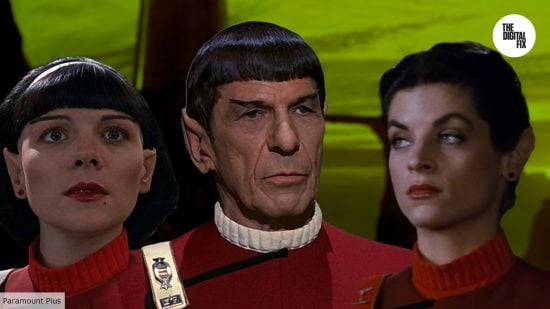
James Osborne
Published: Oct 19, 2023
What are the Vulcans in Star Trek? Even more so than the Klingons, Borg, or Romulans, Star Trek’s Vulcans are absolutely integral to the franchise and have been since the very beginning, both in-universe and out of it.
In fact, part of Star Trek ‘s enduring popularity is all down to one of the best Star Trek characters ever: the (half-)Vulcan, Spock . In the decades since his introduction, we’ve learned so much more about Vulcan lore through new Star Trek series and movies. Now, as Vulcan experts, we’ve collated the answers to all your questions in one handy place.
What are Vulcans, and where do they come from?
Vulcans are a highly advanced humanoid species native to the planet Vulcan in the Alpha Quadrant.
Their planet Vulcan (renamed in the 32nd century to Ni’Var) is known for its towering statues, red hues, rocky cliff faces, and arid environment.
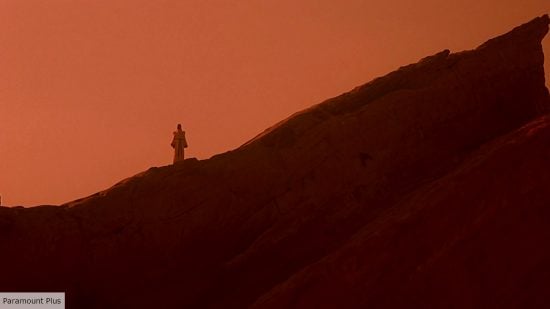
As one of the founding members of The Federation, the Vulcans wield enormous influence across the Alpha Quadrant shaping the direction of the fate of the galaxy. In fact, it was the Vulcans who made first contact with the humans (as seen in the events of First Contact, certainly the best of the TNG-era Star Trek movies ) after Zefram Cochrane successfully developed functioning warp drive technology in the year 2063.
Since then, Vulcans have formed a positive relationship with humans and other members of The Federation, and many Vulcan individuals can be seen serving in Starfleet (Starfleet even has entirely Vulcan-manned ships). However, further ahead in the Star Trek timeline after the events of The Burn as depicted in Discovery, Vulcans withdrew from intergalactic affairs though ultimately rejoined The Federation with help from Michael Burnham and co.
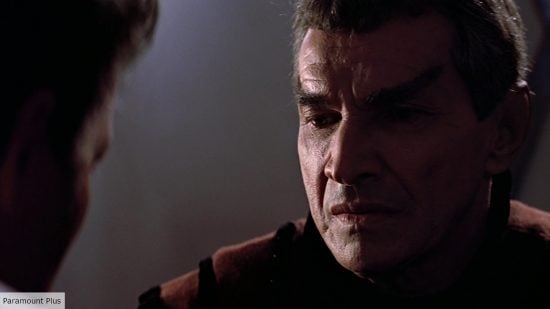
Vulcan logic explained
Despite being known as cold and emotionless devotees of logic, Vulcans are actually an extraordinarily emotional, intense, and volatile species that use logic in order to suppress this natural state and gain control over themselves in search of truth.
This deference to the philosophy of logic, therefore, is one of the overarching traits of Vulcans and Vulcan society as a whole. Vulcans place a great emphasis on the virtues of meditation, and other reflective rituals, which they use to connect with logic and navigate their challenges.
Since birth, they are conditioned to control their emotions and set them aside in favor of logic, and the ultimate goal for a Vulcan is to undergo the Kolinahr: a symbolic ritual to purge all remaining emotions once a sufficient level of logical adherence has been achieved.
While Vulcans believe this to benefit their lives on an individual and personal level, the origin of their philosophy has much broader roots. Prior to finding logic, Vulcans were are warlike and aggressive species with a tumultuous and violent history defined by an unending cycle of conflict caused by their explosive emotions.
Devoting themselves to logic allowed them to prevent their feelings from clouding their judgment and perception of what was true: in turn, Vulcan society found peace, and logic became the central tenet of their philosophy.
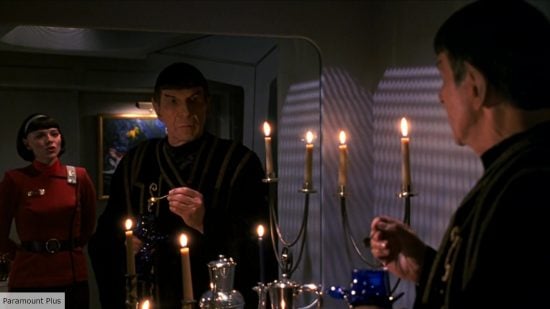
Vulcan biology explained
Vulcan biology is one of the most fascinating aspects of the species because it differs so vastly from human biology despite their exterior similarities.
On a superficial level, Vulcans are identifiable by their pointed ears, upward-angled eyebrows, and (mostly) straight, dark hair. While they’re approximately the same height as humans, they’re also three times as strong and possess vastly superior reaction times. That makes Vulcans even more physically intimidating than Klingons (though Data would still be able to take one on in a fight).
If you do manage to make one bleed though, you’ll find Vulcan blood to be green rather than red due to the oxidation of the copper in their blood (rather than the iron in human blood, which turns red when exposed to air).
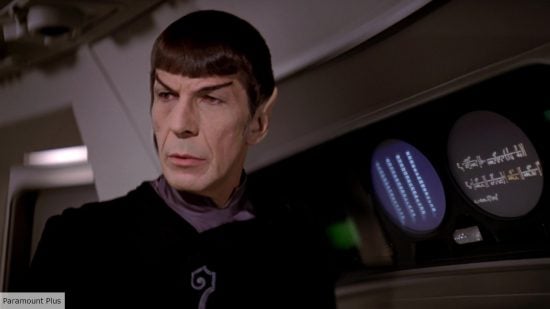
Having evolved on their harsh, hot home planet, Vulcans are adapted to survival which means they can endure high temperatures, a lack of water, and a lack of sleep far better than any human. They also beat humans when it comes to their age with their enormously extended lifespans: an average member of the species will live for 200 years or more.
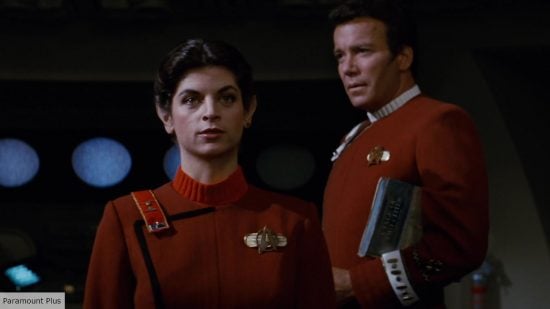
Notable Vulcans throughout Star Trek history
From Chief Science Officers to the Heads of Security, Vulcans have had a diverse array of roles in Star Trek, and a few in particular have established themselves as being especially noteworthy within the canon.
The first and most obvious is Spock, alongside his father Sarek, and his brother Sybok. The whole family had a significant impact on the affairs of the galaxy, as seen throughout the stories of TOS, Strange New Worlds, the TOS movies, and even TNG.
Sticking with the theme, there’s also Spock’s fiancée T’Pring, whose betrayal of Spock (re-contextualized in Strange New Worlds to make her a much more sympathetic character) nearly resulted in the death of Kirk.

In the TOS movies, Spock was joined by the iconic Saavik and Valeris: two of his proteges. Since then, other notable Vulcans have been integral to the adventures seen in other Star Trek series, with T’Pol in Enterprise, Tuvok in Voyager, and T’Lyn in Lower Decks.
None are quite as iconic as Spock, though Tuvok probably comes closest. The character (Chief Security and Tactical Officer) is one of the best in Voyager where he serves as Janeway’s closest adviser and confidant, and the third in command just behind Chakotay. He even showed up again in Picard season 3 to promote his former Kal-toh adversary Seven of Nine.
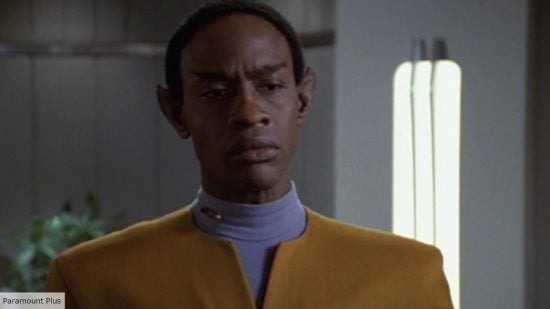
And that’s just about it for everything you need to know about Star Trek’s Vulcans. For more Star Trek lore, see our guide to the Borg and the history of the USS Enterprise . You can also see our thoughts on the best way to watch the Star Trek movies in order and see what else is new on Paramount Plus other than Star Trek, before swapping franchises and seeing what’s going on with Avatar 3 and the new Star Wars movies .
James Osborne After graduating from the University of York with a degree in archaeology (inspired by Captain Picard), James worked with the news team at Screen Rant while contributing features to Vulture, The AV Club, Digital Spy, FANDOM, and the official Star Trek website. Now, he writes about all things sci-fi and fantasy at The Digital Fix with an 'Enterprise-D ambiance' playlist on loop. He's a seasoned expert on all things Star Trek , Lord of the Rings , Star Wars , and Yellowstone , and is more than willing to share his hot takes on TNG which he believes is the greatest series ever made.
From Vulcans to Tribbles: Best 'Star Trek' Species
From Romulans to The Borg, these are 'Star Trek's best alien species with the most interesting storylines.
Star Trek is bigger than ever right now. Thanks to the launch of the new streaming service Paramount+, Trekkies have been simply overwhelmed by the amount of new content at their disposal. The shows Discovery , Picard , Lower Decks, and Prodigy are all returning, and the prequel series Strange New Worlds is in active development. The franchise’s producers Alex Kurtzman and Heather Kadin have promised that there are many other new projects coming soon, and after years of delays, a new Star Trek movie is set to hit theaters on December 2023. The currently untitled fourth entry in the “Kelvin Timeline” series will be directed by WandaVision creator Matt Shakman .
It goes without saying that Star Trek is one of the most influential, iconic, and beloved media franchises in history. Between the various shows, films, books, comics, games, and tie-in material, Gene Rodenberry ’s landmark universe has one of the largest and most loyal fanbases ever. Rodenberry created an optimistic version of the future, where humanity had learned to co-exist with many alien species. In the franchise’s extensive history, these unique species have taken on in-depth cultures, languages, and backgrounds. Obsessive Star Trek fans have developed an Encyclopedic knowledge of their distinct characteristics. Star Trek is a massive property, and as a result there are subsections within the fandom that prefer different alien species of another based on what stories appeal to them. Some stories and films have featured different alien species more prominently than others. Narrowing down the greatest aliens is no easy task, but you can’t go wrong with these great species.
RELATED: 'Star Trek: Strange New Worlds' Teaser Reveals New Look at Celia Rose Gooding's Uhura
You wouldn’t have Star Trek without the success of The Original Series , and you wouldn’t have The Original Series without Spock. Although the competition is fierce, there may not be another Star Trek character that is as beloved as Leonard Nimoy ’s Mr. Spock. Half-Vulcan and half-human, the logical character has been appearing in great Star Trek stories since 1966. The Vulcan race has been developed around his iconic performance, but there are many other great Vulcan characters in the universe’s history. The savior Surak, Spock’s father Sarek, the Enterprise hero Tuvok, and the ambassador Soval are just a few of the best.
The Vulcans’ sister species the Romulans are almost the complete opposite of their philosophical counterparts. The Romulan culture is based on conflict, and throughout the franchise’s history, the two alien species have frequently come into conflict. Romulans first appeared in The Original Series episode “Balance of Terror,” and their empire inspired many of the greatest Star Trek villains ever, including Spock’s tormentor Nero, the powerful Paraetor Neral, and the Federation’s rival Commander Tomalak.
There aren’t many Star Trek villains as truly frightening as The Borg. First appearing in The Next Generation , the hivelike species assimilates all of its opponents into servants of “The Collective.” Patrick Stewart ’s Captain Picard meets his greatest challenge in the beloved two-part storyline “The Best of Both Worlds,” where he is captured and assimilated to the villainous creatures. Picard deals with the post-traumatic stress disorder of his experiences well into the future; he’s forced to face his old enemies again in the excellent 1996 film Star Trek: First Contact . With the phrase “Resistance Is Futile,” The Borg is synonymous with immediate danger.
The Klingon Empire is one of the most powerful bodies in the Star Trek universe. The warrior species has a culture entirely based on combat and trial, with a caste-like system that divides them by their different rank. Kirk, Spock, and the U.S.S. Enterprise crew face off against the Klingons many times throughout the run of The Original Series . However, The Next Generation proved that not all Klingons were villains. The Next Generation fleshed out the Klingon culture in a more empathetic way, and introduced the USS Enterprise-D ’s Klingon security officer Worf. Worf’s bravery and loyalty made him one of the most valuable assets to Captain Picard’s crew, and he returned as a major part of Star Trek: Deep Space Nine ’s later seasons.
Cardassians
One of the most important new species introduced in The Next Generation was the Cardassians, who first appeared in the season four episode "The Wounded". Although the militaristic aliens were renowned for their brutality, unlike The Borg, each Cardassian character acted as an individual. The Cardassian species had developed their ruthless qualities as a result of many hardships, as their home planet had been ravaged by war and famine. The Cardassians kept their culture under strict authority, with a powerful surveillance system, dangerous police force, and strong nationalism within their military dictatorship. The Cardassians waged war against the Federation during Deep Space Nine when they joined the Dominion in an epic conflict.
While many of the most memorable Star Trek aliens are antagonists, the Ferengei are thankfully a great source of comedic relief. The quirky schemers tended to have greedy attitudes, but they haven’t historically been that malicious in nature. The Ferengei were more of a constant annoyance to Captain Picard’s Enterprise crew throughout The Next Generation than a threat like The Borg, and they even proved to be allies a few times. The Ferengi bartender Quark and his brother Rom added a great humorous addition to Deep Space Nine , which otherwise is one of the franchise’s more serious shows.
We’re always going to have a little trouble with Tribbles. The cute, furry species made their debut in the fifteenth episode of The Original Series season two, and fans are still a little divided on whether the adorable creatures are some of Star Trek ’s weakest features or one of its greatest assets. These plushy little guys tend to multiple, and they do it fast , causing problems for multiple generations of Star Trek heroes. Tribbled popped up again in The Animated Series episode “More Trouble, More Tribbles,” the Deep Space Nine episode "Trials and Tribble-ations,” and the Short Treks episode "The Trouble with Edward.” Amusingly, the Klingons considered the Tribbles to be their mortal enemies. Tribbles occasionally served a good purpose; in Star Trek Into Darkness , Bones is able to replicate Khan’s super blood in the Tribbles, thus saving Kirk’s life.
- Entertainment
- Why Aliens Are So Important to <i>Star Trek</i>
Why Aliens Are So Important to Star Trek
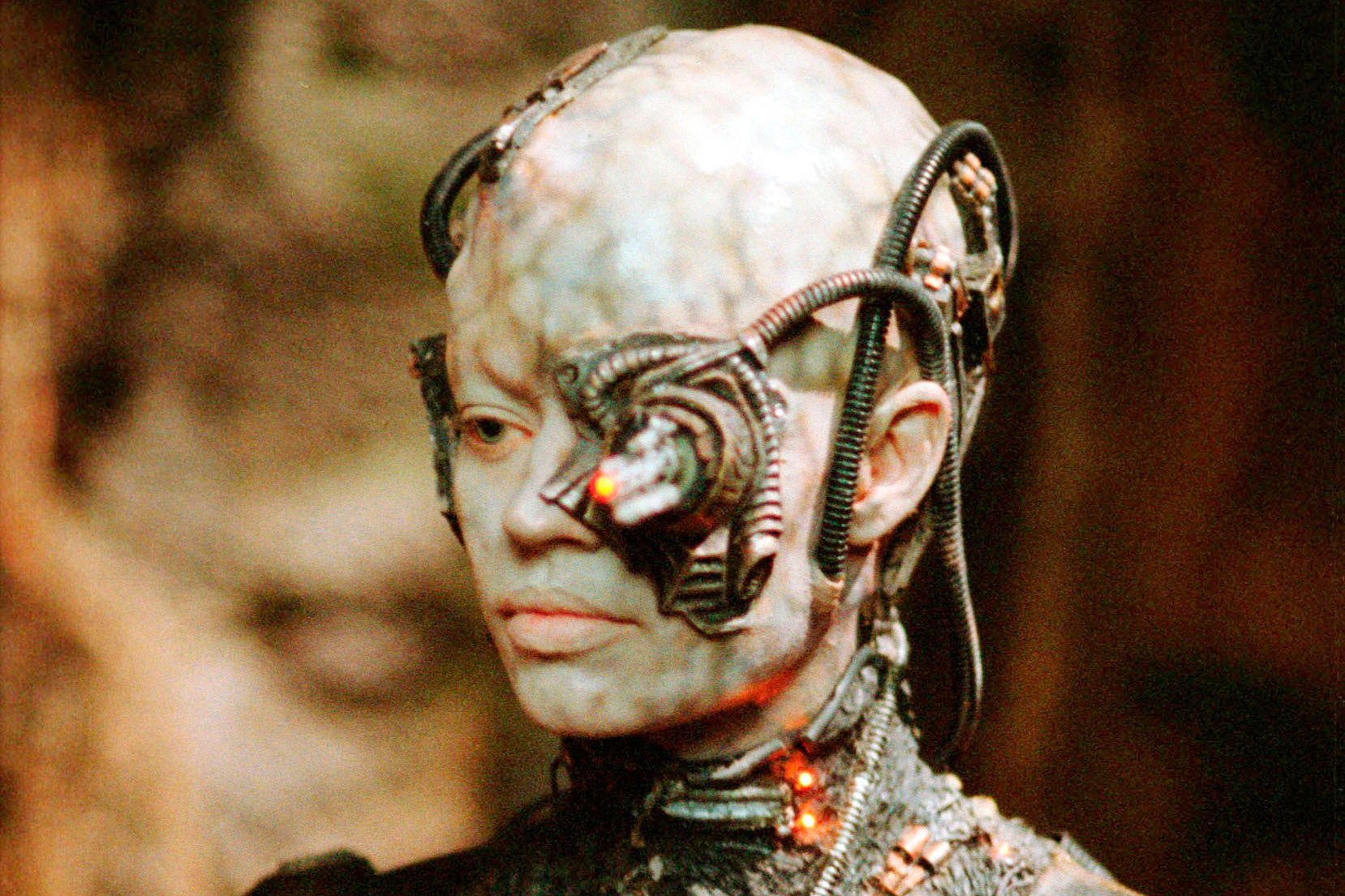
Excerpted from TIME’s Star Trek: Inside the Most Influential Science-Fiction Series Ever . Available at retailers and at Amazon.com .

Since the time of the Greek philosopher Anaximander, humans have gazed up at the heavens and wondered: Is anyone else out there? For some, the idea that we might be the most advanced beings in all of creation offers a sense of supremacy. Others find it a lonely thought.
Reality has yet to offer a conclusive answer one way or the other, leaving our imaginations to run wild. If aliens do exist, what might they look like? How would they behave? And crucially: Would they be friend or foe? Thinkers no less great than the physicist Stephen Hawking have warned of the latter possibility. “If aliens ever visit us, I think the outcome would be much as when Christopher Columbus first landed in America, which didn’t turn out very well for the Native Americans,” Hawking remarked in a 2010 documentary on the subject.
Thankfully for the curious among us, science-fiction writers have stepped up to fill our imaginations with myriad possibilities.
Their creations have extended far beyond the archetypical “little green men.” H.G. Wells’s 1898 War of the Worlds, widely hailed as an exemplar of the genre, gave us terrifying Martian invaders and their tripodal death machines. The Day the Earth Stood Still (1951) offered Klaatu, who visited Earth to urge humanity to end our warlike ways. And of course there was E.T., the disarmingly cute alien simply in need of a ride home.
But nothing in science fiction has contributed to the depth of the extraterrestrial encyclopedia like Star Trek. From the Bajorans (a proud people struggling to recover from another species’s hostile occupation of their world) to the Tamarians (a seemingly incomprehensible race that turns out to communicate through mythology and metaphor), Star Trek’s writers have dreamed up nearly 300 different alien species and counting, according to the fan website Memory Alpha. And that’s just the humanoids.
How can one franchise spawn so many aliens—and so many memorable ones, at that? Necessity, as they say, is the mother of invention. Science fiction typically uses spaceships, death rays and time travel as devices to offer ominous warnings about the ways humanity can go awry. Star Trek creator Gene Roddenberry flipped that script, introducing to a 1960s audience a future in which an interated cast of humans (and, just to drive the point home, one actual alien) work together to better understand their universe.

That utopian vision was essential to Trek’s DNA, but it was also a tremendous challenge for one group of people: Star Trek writers, who faced the daunting task of writing stories in which the main characters all got along just fine.
“Gene was very big on not wanting to create conflict among the characters on the show,” says Rick Berman, who led the Star Trek franchise after Roddenberry died in 1991 until 2005 and produced several series and feature films. “He felt that humans, especially Starfleet humans, had evolved to a point where he didn’t want to see conflict between them.”
Yet conflict is at the core of all great storytelling. So if the Enterprise crew couldn’t squabble with one another, Star Trek writers had to find friction elsewhere. Aliens came to the rescue. “Often we were telling stories of how humans had progressed, or not, in the far reaches of space,” says longtime Star Trek writer D.C. Fontana. “But sometimes the theme of the tale was better told by demonstrating how aliens approached or solved problems, or how they failed.”
Things got off to a rocky start. Putting aside Spock—a full-fledged member of the Enterprise crew—the first extraterrestrial to appear on Star Trek was a C-list monster that could have been pulled from any bad ’50s sci-fi flick. A shape-shifter with a serious salt craving, the nameless creature killed off Enterprise crew members by sucking the sodium out of them. The so-called “salt vampire” wasn’t a big hit. Thankfully, matters improved from there.

Humans are complex creatures, capable of being logical, tactical, aggressive, greedy and lustful all in a single one-hour episode. But Star Trek aliens are typically guided by one prime mover. Often it is some trait shared by many people. A desire for conquest, perhaps, or the pursuit of wealth or the urge to protect one’s offspring. That made them a thinly veiled stand-in for whatever driving force they represented, giving the writers a way to craft stories that were less about aliens and more about us. Simply put, Star Trek aliens are a mirror in which we see the best and worst of ourselves—and one in which we see that we’re not as different from one another as we might think.
“The concept of having aliens on a week- to-week basis, sometimes new, sometimes ones that the audience was familiar with, gave the writers the ability to represent all the different qualities of humanity,” says Berman. “Whether it’s avarice or whether it’s a hive-like mentality or whether it’s emotions or whether it’s a desire to be more human, these were all qualities that the aliens allowed us to play with. We could not have done the show without that.”
Case in point: In the third-season Next Generation episode “The Survivors,” Capt. Jean-Luc Picard and his crew find a couple who appear to be the only survivors of an attack on a Federation colony. But when they are offered safe harbor aboard the Enterprise, they refuse, insisting they be left where they were found. It’s an odd request, given their situation. A series of other strange happenings, such as a warship appearing to drive the Enterprise away from the planet, convinces Picard that something is amiss with the pair, who are named Kevin and Rishon Uxbridge. Picard is eventually able to trick Kevin into revealing the truth: he’s not a human but a member of an all-powerful species called the Douwd. Kevin admits that he created a fictional version of Rishon after she was killed in an attack by a murderous race called the Husnock. What’s more, Kevin, who considers himself a pacifist, reveals that in his rage over losing his wife, he killed the Husnock. And not just the Husnock who attacked his world but all of them, everywhere in the universe.
Kevin’s reaction is perfectly “human.” Who hasn’t wished ill will on those who do us wrong? The difference, of course, is that Kevin has the power to satisfy his rage to a horrific extent. Picard, typically motivated by justice, admits that the Federation has “no law to fit” Kevin’s crime, instead letting him live in exile on the planet. The captain concludes, “We leave behind a being of extraordinary power and conscience. I am not certain if he should be praised or condemned. Only that he should be left alone.”
With the possible exception of Spock and the rest of the Vulcans, Star Trek’s best-known aliens are the Klingons. A ruthless warrior race obsessed with battle and honor, the Klingons originally served as a two-dimensional foil for Kirk and company. Many have viewed them as a bellicose stand-in for the great space-race enemy of the original series’ era, the Soviet Union. But so popu- lar have the Klingons become over the decades that theirs is the most widely spoken fictional language in the world, according to Guinness World Records. (Take that, Lord of the Rings fans.) There’s even an ongoing copyright battle over who owns the Klingon language, which has generated some of the more entertaining legal briefs of our time.
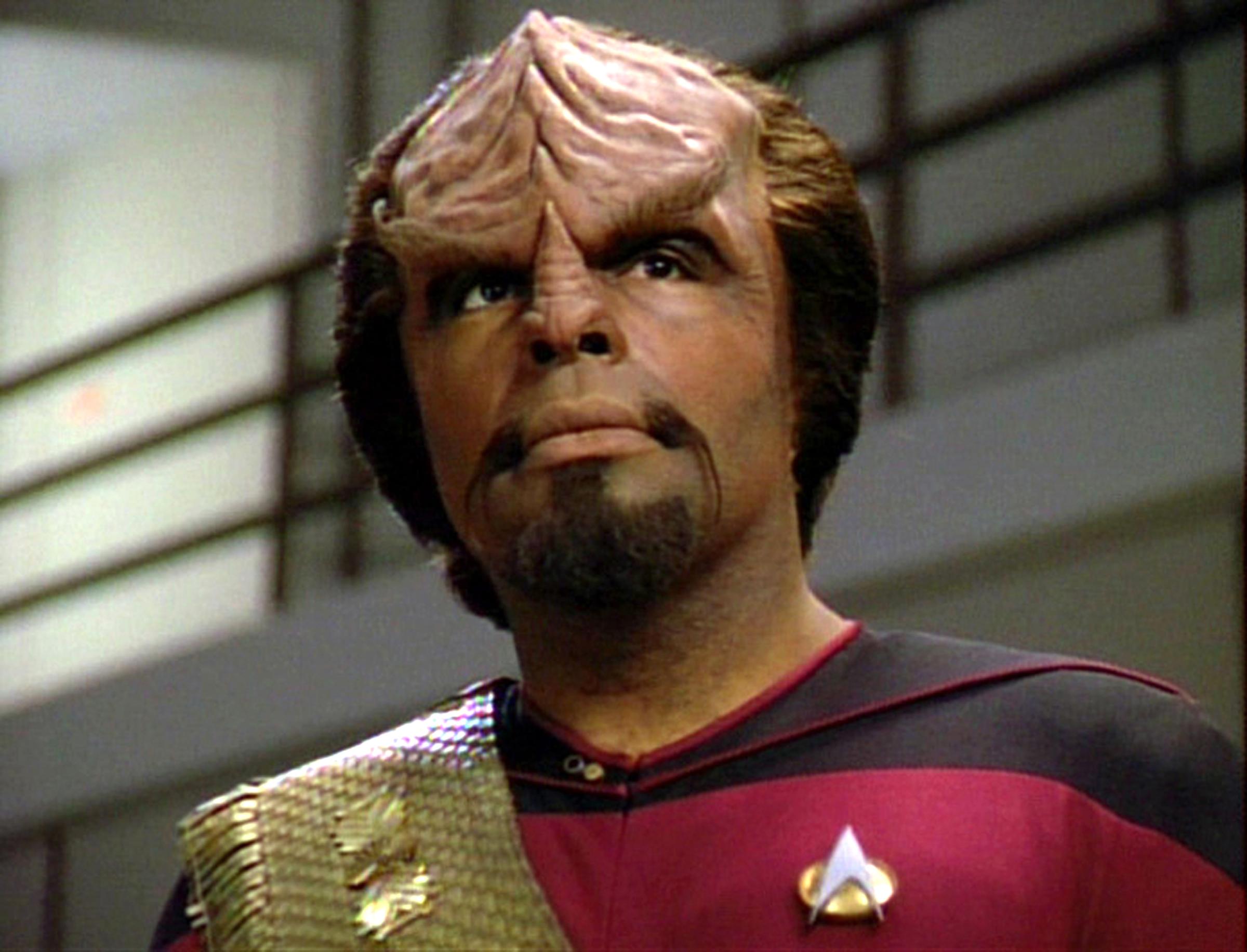
At least some of the credit for that popularity is due to actor Michael Dorn, who played the Klingon bridge officer Worf in The Next Generation. That series took the original, more-cartoonish Klingons and gave them depth and relatability. Klingons, as it turns out, are a lot like us. The Klingons are warmongers, like some humans. The Klingons are obsessed with rituals, like some humans. The Klingons are driven by a fierce dedication to their family, like some humans. One of Star Trek’s best Klingon stories came in “Sins of the Father,” a third-season Next Generation episode in which Worf’s late father is accused of treason. As much as it pains him to do so, Worf decides to shoulder the blame in accordance with Klingon custom, despite his father’s innocence, a move that will help preserve the Klingon Empire’s political status quo and keep the empire from spiraling into chaos that could ultimately harm millions. It’s a deeply human story, a meditation on family pride as much as it is a revealing look into the intricacies of Klingon politics.
If the Klingons were Star Trek’s original villains, the Borg were the show’s best. A technologically advanced race of cyborgs, the Borg are bound together into a hive mind called “the Collective.” Just looking at the Borg, a terrifying hodgepodge of man and machine, is enough to send shivers down your spine. But the real terror lies in their motivation: intergalactic racial purity. When the Borg encounter a new species, they either add it to the Collective through forced “assimilation” or simply kill it off.
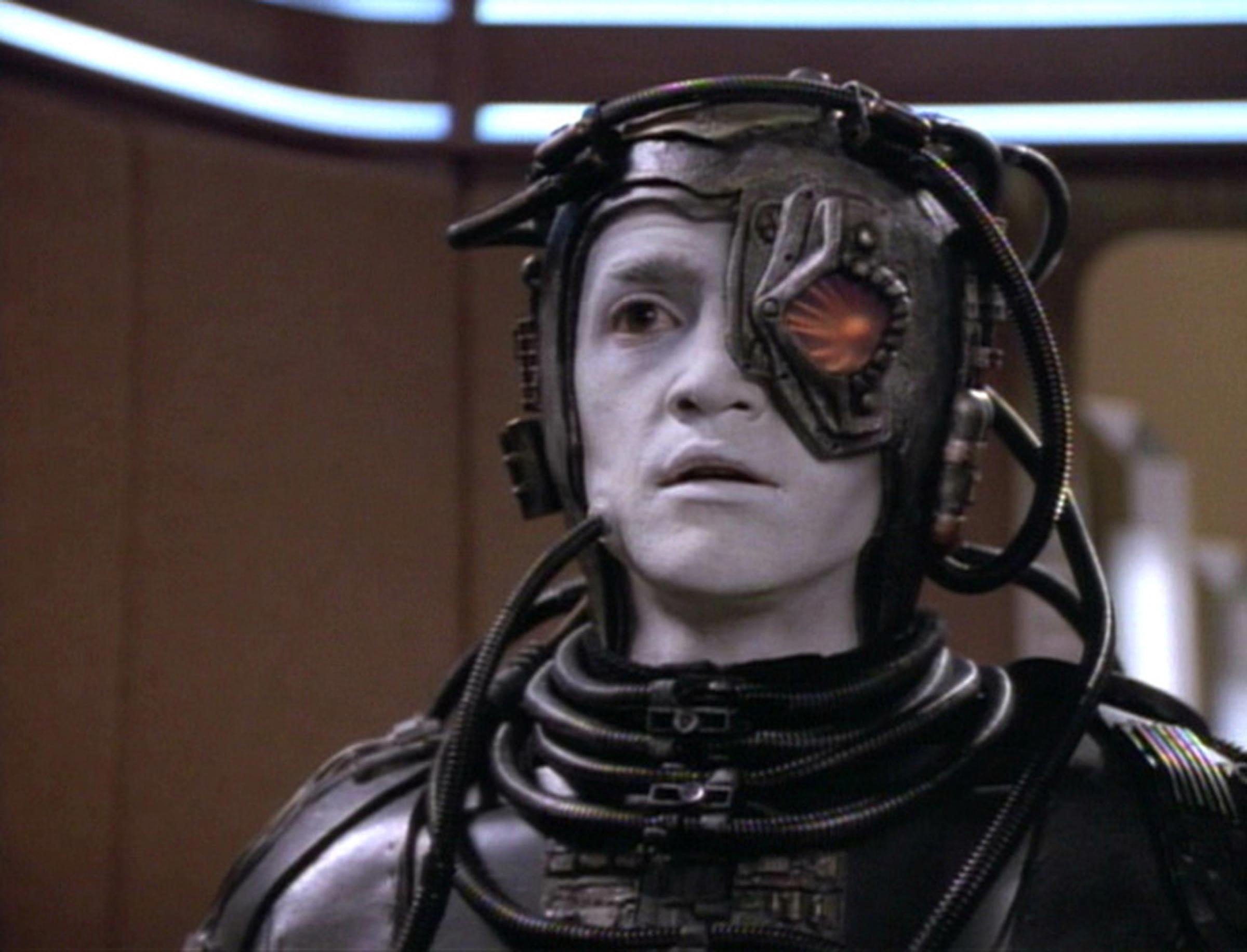
It’s unclear which is the worse fate. In part, Star Trek is a celebration of humanity’s individuality. The Borg are everything Trek’s humans are not: obedient, robotic, conformist. So great is the fear of assimilation that in the Star Trek film First Contact, an Enterprise crew member who’s going through the horrific process begs Capt. Picard to kill him out of mercy. Picard—who had once been assimilated himself but was saved in a daring rescue by his crew—obliges. “The concept of being assimilated was terrifying, because it seemed like you had no control over it and no ability to combat it,” says Jonathan Frakes, who played Star Trek’s Cdr. William T. Riker and directed First Contact as well as Star Trek: Insurrection.
The Borg, who first appeared in a 1989 episode of The Next Generation, are typically considered a commentary on fascism and racial cleansing. But in a sense, they are aliens posing questions we didn’t even realize we would soon be facing. Can we real-world humans be addicted to constant connectivity through our smartphones, as the Borg are to the Collective? (Cut a Borg off from the hive mind, and the alien’s nonplussed reaction is not unlike that of a teenager stripped of an iPhone.) Does social media give us a platform on which to connect with others to enhance our common understanding, or does it create a hive mind that rejects unpopular opinions, as does the Collective? Should we enhance our physical and mental capabilities with technological implants, as the Borg do? Watch the Borg stories with these pressing questions in mind, and they only become more fascinating.
Given the prominence of races like the Klingons and the Borg, it might seem as if Star Trek’s aliens are almost always villains. That’s far from the case. The greedy Ferengi, introduced early in The Next Generation, were intended as such at first. But fans considered them too silly to be a serious threat. Instead, the Ferengi soon turned into walking, breathing commentaries on the advantages and flaws of unbridled capitalism. If Donald Trump were a Star Trek alien, he would be a Ferengi. They’re driven entirely by making money; they always want the better part of the deal. (They also happen to be some of the most sexist creatures in Trek: they outright ban women from business, though their society undergoes reforms as their story line progresses.) These characteristics put them in stark contrast with Star Trek’s humans, who work not for money but “to better ourselves and the rest of humanity,” as Capt. Picard once put it.
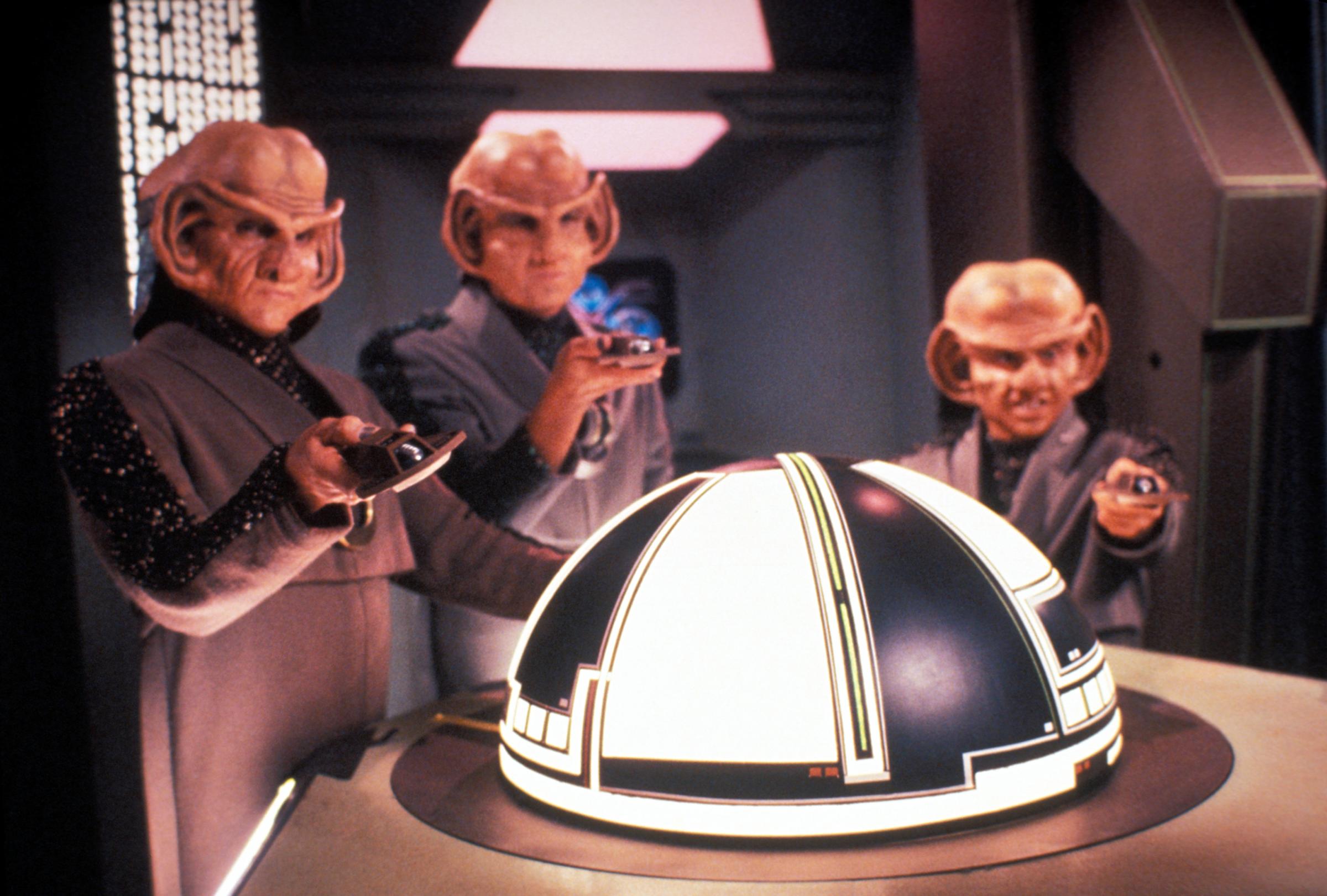
Star Trek’s quintessential Ferengi was Quark, a seedy intergalactic businessman and bartender who was brought to life by actor Armin Shimerman in Deep Space Nine, the franchise’s third television series. Quark often quoted from “the Rules of Acquisition,” a sort of Ferengi guidebook that could double as Gordon Gekko’s personal manifesto. Example rules include “Never place friendship above profit,” “Never allow family to stand in the way of opportunity” and “War is good for business.” But Deep Space Nine’s writers went beyond using Quark as a mere punching bag for Wall Street. In the season-three episode “The House of Quark,” for instance, we see him use his business-like cunning to escape certain death in a duel with a Klingon. The lesson? Sometimes greed is good.
Star Trek writers were skilled at constantly adding depth to the aliens who reappeared through the series. Just as the Klingons’ belligerence was leavened with stories about their love of honor, the warlike Romulans turned out to be literally related to the Vulcans—a glimpse at Trek’s most logical race with the worked only in pairs, providing a lesson about the power of cooperation. And Star Trek: Voyager’s “Year of Hell” offered the history-alerting Annorax, who aimed to use his time weapon to restore his people’s empire to its former glory but killed his own wife in the process, revealing the cost of stubborn pride.
On one level, Star Trek is a science-fiction show about a group of intellectually enlightened humans exploring the far reaches of the galaxy, all to better their understanding of their world. But the show is really about us, back here in the present day, and the common ties that bind us. What better way to show us we’re all alike than through the lens of outsiders? “Aliens are really important in science fiction because they give a little distance character-wise and story-wise so that you can actually have stories about beauty and youth and racism, and on and on and on,” says John de Lancie, who played Star Trek’s godlike character Q. “It puts it on the character of an alien to be able to say things that sometimes you can’t say straight out. I think the aliens in Star Trek and the aliens in most science fiction have a lot of value in that respect.”
More Must-Reads From TIME
- Jane Fonda Champions Climate Action for Every Generation
- Passengers Are Flying up to 30 Hours to See Four Minutes of the Eclipse
- Biden’s Campaign Is In Trouble. Will the Turnaround Plan Work?
- Essay: The Complicated Dread of Early Spring
- Why Walking Isn’t Enough When It Comes to Exercise
- The Financial Influencers Women Actually Want to Listen To
- The Best TV Shows to Watch on Peacock
- Want Weekly Recs on What to Watch, Read, and More? Sign Up for Worth Your Time
Contact us at [email protected]
You May Also Like
15 of the Most Bizarre Alien Species Featured in 'Star Trek'
"star trek" aliens.

"Star Trek" is filled with unusual aliens, ranging from the humanoid to the crystalloid to the god-like. Here are some of the more unique species from the live-action "Star Trek" series. Please note: We deliberately exclude the more well-known alien races, and limit each of the series to three entries to try to include samples from across the canon. If we missed anything bizarre, tell us in the comments!
1. Salt vampire ("Star Trek: The Original Series," 1966-1969)
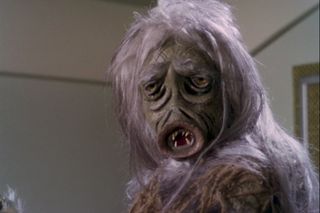
The very first episode of "Star Trek" showed promise when it came to weird aliens. An old flame of one of the crew members, Nancy Crater, turns out to be a projection of a sort of salt vampire that soon runs amok on the USS Enterprise. This alien species cannot live long without salt, so it attacks crew members and sucks them dry of essential salts. The creature is eventually stopped in part by a sort of mouse trap that — of course — uses salt. [ What I Learned by Watching Every 'Star Trek' Show and Movie ]
2. Horta ("Star Trek: The Original Series," 1966-1969)

This is a species of silicon-based life (humans, by comparison, are carbon-based) that prefers to feed on rocks. In a moving episode, "The Devil In The Dark," the crew discovers that the aliens are actually intelligent and very loyal to their offspring — but only after the Vulcan alien Spock does a mind-meld with one of the creatures, which is being persecuted by miners angry at the destruction it has caused.
3. Gorn ("Star Trek: The Original Series," 1966-1969)
A member of this extremely strong (but intelligent) reptilian species engages in famous hand-to-hand combat with Capt. James T. Kirk in the episode "Arena." The only way Kirk manages to overpower him is by finding the ingredients for gunpowder on the alien planet on which he is trapped, using his own uniform to help with the ignition. As an honorary mention, we should also include The Metrons, a species that can manipulate energy and matter at will — these are the aliens that set up the fight in the first place, because they are mad at their space being invaded.
4. Q ("Star Trek: The Next Generation," 1987-1994)

Simultaneously terrifying and witty, Q is a seemingly supernatural being who pops up on the USS Enterprise periodically to play tricks on the crew. Some of his memorable actions include giving Q-like powers to a member of the Enterprise (arguing that humans always love learning), and putting humanity on trial for its past crimes while wearing period uniforms from over the centuries. Q, however, isn't all trickster. Alongside his antics, he does warn humanity about the approach of the Borg, which is trying to assimilate all species into a collective. [ The Evolution of 'Star Trek' (Infographic) ]
5. Tamarian ("Star Trek: The Next Generation," 1987-1994)
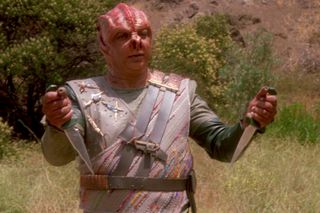
This species is a tongue-twister for the usual translators that Starfleet officers carry. While the translators can literally tell us what the Tamarians are saying, it's hard to understand what is going on because the species is speaking in metaphors. (Some examples from Memory Alpha: "Temba, his arms wide/open," which means a gift, or "the river Temarc in winter," which refers to the need for silence.) In the episode "Darmok," Capt. Jean-Luc Picard must learn to communicate with a Tamarian quickly before they are both killed by a hostile beast.
6. Crystalline Entity ("Star Trek: The Next Generation," 1987-1994)

This alien goes in the "beautiful but deadly" category, as the crystalline entity was breathtaking to watch in space — it looked a bit like a snowflake, or small and shiny diamonds. However, the entity had a nasty side to it: It could quickly devour all life in its wake. The USS Enterprise finally defeated the entity by sending graviton pulses that eventually broke it into pieces. But sadly, the crew couldn't stop the pulses in time when they realized the creature might be trying to communicate with them.

7. Changeling ("Star Trek: Deep Space Nine," 1993-1999)
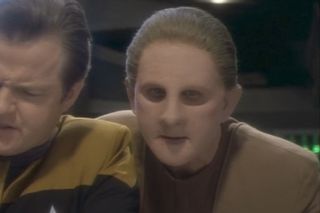
Fans of the series will instantly remember changelings, as their numbers included one of the series' main characters — Odo, the sarcastic security officer aboard the space station Deep Space 9. Changelings were made up of an orange liquid that in the "Star Trek" universe is technically referred to as a "morphogenic matrix." Changelings were able to morph into pretty much anything they wanted to, including inanimate objects or even to resemble humans. [ Love of 'Star Trek' Inspires Highly Illogical Careers ]
8. Jem'Hadar ("Star Trek: Deep Space Nine," 1993-1999)

Jem'Hadar were one of a few "Star Trek" aliens with very different life cycles than humans. In their case, they were created in "birthing chambers" and were able to reach maturity in just three days. They also fed on a drug called Ketracel-white, which contained an enzyme they needed to survive. That enzyme was deliberately withheld during birthing by the Vorta, who created the Jem'Hadar; this gave the Vorta power over the Jem'Hadar and a captive economy for distributing the drug.
9. Trill ("Star Trek: Deep Space Nine," 1993-1999)

A main character on "Deep Space Nine" was from the Trill species — Jadzia Dax. Most of the Trill were fairly unremarkable, but there were a small number (including Dax) who lived with a symbiont inside their bodies. This symbiont was intelligent, but required a host organism to survive; it was common to transfer symbionts to young bodies when the older host organism was close to death. This meant that in the case of Dax, the symbiont transferred from an older man to a younger woman, prompting surprise from an old friend, Capt. Benjamin Sisko, the first time he met the younger Dax on Deep Space 9.
10. Hirogen ("Star Trek: Voyager," 1995-2001)
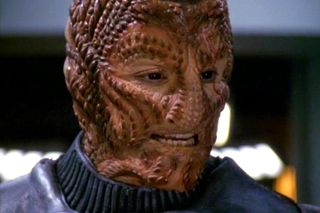
This alien was a brutal enemy of anything in the "Star Trek" universe, simply because the Hirogen consider themselves the dominant species and anything they run across as prey. Their entire culture was focused on hunting down other species, and they had the ability (if required) to break down bones and muscle tissue to eat the prey. Not someone you'd want to invite to dinner.
Join our Space Forums to keep talking space on the latest missions, night sky and more! And if you have a news tip, correction or comment, let us know at: [email protected].
Current page: Page 1
Get the Space.com Newsletter
Breaking space news, the latest updates on rocket launches, skywatching events and more!

Elizabeth Howell (she/her), Ph.D., is a staff writer in the spaceflight channel since 2022 covering diversity, education and gaming as well. She was contributing writer for Space.com for 10 years before joining full-time. Elizabeth's reporting includes multiple exclusives with the White House and Office of the Vice-President of the United States, an exclusive conversation with aspiring space tourist (and NSYNC bassist) Lance Bass, speaking several times with the International Space Station, witnessing five human spaceflight launches on two continents, flying parabolic, working inside a spacesuit, and participating in a simulated Mars mission. Her latest book, " Why Am I Taller ?", is co-written with astronaut Dave Williams. Elizabeth holds a Ph.D. and M.Sc. in Space Studies from the University of North Dakota, a Bachelor of Journalism from Canada's Carleton University and a Bachelor of History from Canada's Athabasca University. Elizabeth is also a post-secondary instructor in communications and science at several institutions since 2015; her experience includes developing and teaching an astronomy course at Canada's Algonquin College (with Indigenous content as well) to more than 1,000 students since 2020. Elizabeth first got interested in space after watching the movie Apollo 13 in 1996, and still wants to be an astronaut someday. Mastodon: https://qoto.org/@howellspace
This Week In Space podcast: Episode 105 — Apoc-eclipse 2024!
'Star Trek: Discovery' season 5 episode 2 sows the seeds of seasonal plot threads (Under the Twin Moons recap)
I'm driving 6 hours through New York's Adirondacks to see the 2024 total solar eclipse from Potsdam. Here's why.
Most Popular
By All About Space magazine May 28, 2023
By Fran Ruiz May 06, 2023
- 2 Total solar eclipse 2024: Live updates
- 3 This Week In Space podcast: Episode 105 — Apoc-eclipse 2024!
- 4 Total solar eclipse 2024: Here's the national weather forecast for April 8
- 5 William Shatner is beaming in to see the 2024 total solar eclipse from Indiana (video)

Fictional species in "Star Trek" - Daily Themed Crossword

Hello everyone! Thank you visiting our website, here you will be able to find all the answers for Daily Themed Crossword Game (DTC). Daily Themed Crossword is the new wonderful word game developed by PlaySimple Games, known by his best puzzle word games on the android and apple store. A fun crossword game with each day connected to a different theme. Choose from a range of topics like Movies, Sports, Technology, Games, History, Architecture and more! Access to hundreds of puzzles, right on your Android device, so play or review your crosswords when you want, wherever you want! Give your brain some exercise and solve your way through brilliant crosswords published every day! Increase your vocabulary and general knowledge. Become a master crossword solver while having tons of fun, and all for free! The answers are divided into several pages to keep it clear. This page contains answers to puzzle Fictional species in "Star Trek".
Fictional species in "Star Trek"
The answer to this question:
More answers from this level:
- The "D" in DJ
- Shape of a rainbow
- "___ It" (Michael Jackson song)
- TV's "American ___"
- Team of two
- Something to scratch
- Furry red muppet on "Sesame Street"
- High speed internet connection: Abbr.
- Golden ____ Bridge
- Track-and-field tournaments
- "____ in there!"
- Kachina doll makers in Arizona
- Window alternative, on a flight
- Word before "loves me" and "loves me not"
- Japanese mint product

- View history
The Xindi (pronounced " ZIN-dee ") were six sentient species who evolved on the same planet in the Delphic Expanse , known as Xindus in the Milky Way Galaxy .
In the early 2150s , the Xindi Council committed an infamous attack on Earth and made repeated attempts to terminate Humans , which changed the course of history and initiated a series of events that helped establish United Earth as a major interstellar power. In at least one future timeline , from where Daniels originated, the Xindi state had, by the 26th century , become a member of the United Federation of Planets .
- 1 Xindi species
- 6 Related topics
- 7.1 Appearances
- 7.2.1 Origins
- 7.2.2 Visualizing Xindi
- 7.2.3 Costumes and sets
- 7.2.4 Performing as Xindi
- 7.2.5 Reception
- 7.3 Apocrypha
- 7.4 External links
Xindi species [ ]
Six different intelligent species developed on Xindus; one of them, the Xindi-Avians , was believed extinct by the 2150s, as the result of a brutal civil war between the six species that destroyed the planet. ( ENT : " The Shipment ") The surviving species were united under the governance of the Xindi Council , which contained two representatives from each species. ( ENT : " The Xindi ", et al. ) The five remaining species were:
- Xindi-Aquatics
- Xindi-Arboreals
- Xindi-Insectoids
- Xindi-Primates
- Xindi-Reptilians
Each of these five remaining species had their own distinct opinion about which was the dominant species, all separately favoring their own. ( ENT : " The Xindi ") There was, therefore, an enormous amount of conflict and distrust between the species. ( ENT : " Exile ") However, the Arboreals and Primates tended to quarrel the least, with most conflict centering on the aggressive Reptilians and Insectoids, or the indecisive Aquatics.
The different Xindi species were extremely similar in their functionally important DNA , sharing over 99.5% despite the apparent physical differences. ( ENT : " The Xindi ") All the Xindi species shared distinctive ridges on their cheekbones and foreheads. ( ENT : " The Xindi ", et al. )
History [ ]
- Main article: Xindi history
The Xindi had a long and turbulent history, characterized by interspecies conflict up until the destruction of their homeworld in the 2030s as the result of an Insectoid and Reptilian plot. ( ENT : " The Shipment ") In the 2150s, they attempted to destroy Earth with a massive weapon . ( ENT : " The Xindi ", et al. )
In the mirror universe , Xindi ships fought in a conflict with the Terran Empire sometime prior to 2155 . ( ENT : " In a Mirror, Darkly ", " In a Mirror, Darkly, Part II ")
In the 26th century of an alternate timeline , Xindi served on the USS Enterprise -J during the Battle of Procyon V against the Sphere-Builders . ( ENT : " Azati Prime ")
Culture [ ]
The Xindi practically worshipped the Guardians , considering them saviors. Children were taught to revere them and give thanks to them at the end of each day . It was a terrible offense to question a Guardian. ( ENT : " The Council ")
Xindi passed down " initiation medals " among the members of a family . ( ENT : " Azati Prime ")
Language [ ]
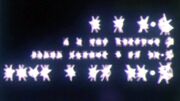
Xindi written script
The Primates, Arboreals, and Reptilians spoke a common language that was recognized by Starfleet universal translators . The Insectoids and Aquatics understood this language, but appeared to be physically incapable of speaking it. Consequently, the Primates, Arboreals, and Reptilians were forced to learn the Insectoid and Aquatic languages.
- List of all Xindi
Related topics [ ]
- Xindi incident
- Temporal Cold War
- Xindi planets
- Xindi starship classes
- Xindi technology
Appendices [ ]
Appearances [ ].
- " The Expanse " ( Season 2 )
- " The Xindi " ( Season 3 )
- " The Shipment "
- " Twilight "
- " Carpenter Street "
- " Proving Ground "
- " Stratagem "
- " Doctor's Orders "
- " Azati Prime "
- " The Forgotten "
- " The Council "
- " Countdown "
- " Zero Hour "
- " Home " ( Season 4 )
- DIS : " ...But to Connect " ( Season 4 )
- PRO : " Crossroads "
Background information [ ]
Origins [ ].
The Xindi were originally not as varied as they became. " At first, there was only going to be one particular race of Xindi, " reported Star Trek: Enterprise concept illustrator John Eaves . ( Star Trek: The Official Starships Collection , issue 24, p. 11) Executive Producer Brannon Braga spent a very long time mulling over the concept which was later to develop into the Xindi. His initial idea was speculating what it might be like if, on Earth, Humans had not been the only lifeforms to develop intelligence but species such as dolphins, insects and other primates had too. ( Uncharted Territory, Part 3: Course Correction , ENT Season 2 Blu-ray special features) Braga admitted, " I always wonder, 'What would Earth have been like if dinosaurs had evolved to become intelligent? And not only that but insects, birds.... What if it happened, there was simultaneous evolution into intelligent organisms and they all lived together?' " ( In a Time of War, Part Three: Final Conflict , ENT Season 3 Blu-ray special features) Braga added to these notions by imagining that such a collection of intelligent lifeforms, if alien, might have a grudge against Earth. " It just all kind of came together, " he noted. ( Uncharted Territory, Part 3: Course Correction , ENT Season 2 Blu-ray special features)
As a result of instructions on how to develop Star Trek: Enterprise – which came from Paramount Pictures , amid the second season – the opportunity to actualize the concept of an alien alliance comprising various related species finally arose. " I knew it was hard to pull off, " admitted Brannon Braga. " But we'd just been given kind of carte blanche to maybe spend a little more money and do something big. " ( Uncharted Territory, Part 3: Course Correction , ENT Season 2 Blu-ray special features)
Co-Executive Producer Chris Black was involved in early discussions about the multi-species facet of the Xindi. Even though it had been decided that only one sentient dominant species would be depicted per planet, the notion of five sentient species who shared a planet was welcomed by the writing staff of Enterprise . (" Countdown " audio commentary , ENT Season 3 Blu-ray special features)
The concept of the Xindi was additionally inspired by the attacks on 9/11 and those responsible for them. Director David Livingston mused, " The Xindi were [...] destroying parts of Earth, so it was reflective of what was going on at the time. " ( In a Time of War, Part One: Call to Arms , ENT Season 3 Blu-ray special features)
Although a badly incinerated Xindi corpse appears in the second season finale " The Expanse " (which was scripted to have "animalistic features"), this effectively hid the fact that, by that point, no design for the physical appearance of the Xindi had been created. (" The Xindi " text commentary , ENT Season 3 DVD ) Brannon Braga recollected, " In terms of who the Xindi were, that didn't come until after the break [between the second and third seasons ]. " ("The Xindi Saga Begins", ENT Season 3 DVD special features) Giving life to the Xindi, designing how they looked, took a total of about two months. ( Star Trek: Communicator issue 149 , p. 50) Commenting on the selection of the five specific species incorporated into the Xindi, Executive Producer Rick Berman stated, " They just were the ones that seemed right for us. It was just something Brannon and I developed; we knew that there was going to be the humanoids and the reptilians because we had touched on those, and then the other three came quite easy. " ( Star Trek: Communicator issue 147 , p. 16) John Eaves offered, " By the time that the script came out we were going to do a multiple version [of the Xindi], kind of like people from different countries. Not necessarily different skin colors but completely different species of creatures, like insectoids, humanoids and so on. The insectoid and humanoid species were the first ones we started working on. " ( Star Trek: The Official Starships Collection , issue 24, p. 11) In the final draft script of ENT Season 3 premiere " The Xindi ", the five species were described thus; " All of these Xindi are intelligent beings that evolved on the same planet, and though they are very different in appearance, they all share a subtle, unifying facial characteristic that hints at their common ancestry. "
Because it obviously wasn't guaranteed that the Xindi would prove successful, Rick Berman expected the aliens might subsequently be eliminated from the series and he therefore came up with a contingency plan of devising numerous stand-alone episodes in which they were not involved. ( In a Time of War, Part Two: Front Lines , ENT Season 3 Blu-ray special features)
Visualizing Xindi [ ]
From the very beginning, Rick Berman and Brannon Braga knew they wanted to depict the Xindi-Insectoids and -Aquatics using CGI . ( Star Trek: The Official Starships Collection , issue 24, p. 14) This extensive use of visual effects technology, with both species typically being depicted entirely using computer-generated figures, tasked the VFX artists. " The challenge of the Xindi for the visual effects team, " explained Visual Effects Producer Dan Curry , " was that we would be creating a pretty high volume of CG characters in a very short period of time. " ( In a Time of War, Part Three: Final Conflict , ENT Season 3 Blu-ray special features) Curry credited the animators and the CG technology involved with making this possible. ( Star Trek: The Official Starships Collection , issue 65, p. 10) Curry recalled of the VFX artists, " We were very excited – we felt that now technology and what we've learned would enable us to do better quality work than we had done in the past with these [all-CGI characters]. " ( Star Trek: Communicator issue 149 , p. 50) " A few years ago it would have been financially impossible to do, " reckoned Rick Berman, midway through the third season. " What has happened now is that we have the technology and the people who can give it to us. The problem is that with our two CG species, the Insectoids and Aquatics, we will probably not see as much as we would like because of the expense. " ( Star Trek: Communicator issue 147 , p. 16)
Much research and development was invested in the character design for the Aquatics and Insectoids, at the start of the third season. [1] (X) The CG artists were well-prepared for the challenge of visually creating the characters. Digital Effects Supervisor John Teska recollected, " I'd already heard that there was gonna be this race of Xindi that, of course, were going to be multiple different kinds of aliens. You know, we had heard that the Insectoids and the Aquatics were going to be CG. " ("Visual Effects Magic", ENT Season 4 DVD special features) The task of designing these new beings went to Dan Curry. Although it's rare for a visual-effects producer instead of the art department to do any design work on Star Trek , Curry had proven he could deliver such work by having designed the Klingon bat'leth . He also had relevant experience of working with a full-CGI creature, in the form of Star Trek: Voyager 's Species 8472 . ( Star Trek: The Official Starships Collection , issue 24, pp. 14-15) Thus, the process of designing the Aquatics and Insectoids began, in both cases, with sketches by Curry, prior to the CG artists developing these designs. [2] (X) The appearance of both species had to seem particularly alien, owing to Berman and Braga's concept of the Xindi. It was made the responsibility of visual effects artists at CGI vendors Eden FX to proceed with the designs. ( Star Trek: The Official Starships Collection , issue 65, p. 10) Eden FX co-founder John Gross remembered, " We worked on [the Xindi insectoids and aquatics] together [with FX artists Dave Morton , Sean Scott , and John Teska], modelling them and rigging them and getting them working. It took a few weeks. " ( Star Trek Magazine issue 118 , p. 30) Other Xindi species were occasionally represented with CGI, including Reptilians in some footage from " Countdown " ("Countdown" text commentary , ENT Season 3 DVD ) and Arboreals in " The Shipment ".
Costumes and sets [ ]
Virtually all the clothing worn by the Xindi was designed by Bob Blackman ; this even included ambassadorial robes worn by the Insectoids, though Insectoid armor (the only exception) was designed by Dan Curry. ( Star Trek: Communicator issue 149 , pp. 50 & 51)
Under the aegis of Production Designer Herman Zimmerman , the art department had to design the look of the sets for each Xindi species. " That was a good challenge, " said Zimmerman, " just because we had to make them different enough that you always knew where you were. " ( Star Trek: Communicator issue 151 , p. 56)
The shipboard graphic layouts for the various Xindi species were designed to resemble each other (at least, in the case of the Xindi-Primates and Xindi-Reptilians). However, each species was given a different color scheme; the Reptilians had primarily blue control graphics, whereas the Primates had green ones, and the Insectoids' were colored red. (" The Xindi " text commentary , ENT Season 3 DVD ) Herman Zimmerman offered, " We did do a lot of very specific Xindi graphics and, within the larger framework of the Xindi, each Xindi species had their variation of those graphics. " ( Star Trek: Communicator issue 151 , p. 56)
Performing as Xindi [ ]
Of all the guest stars and recurring actors who featured on Star Trek: Enterprise , former longtime Star Trek casting director Ron Surma cited the group of performers who played recurring Xindi as a highlight, enthusing, " I liked the Xindi guys [...] Those guys were a lot of fun. " Surma also pointed out that Randy Oglesby , Rick Worthy and Scott MacDonald had all made repeated guest appearances on Star Trek before portraying recurring Xindi. [3] The actors themselves were extremely grateful for the repeated opportunities to appear on the series. The fact that filming the Xindi Council scenes required full days, however, initially meant that the Xindi-playing performers did not meet any of the series' regular cast members (this remained the case until at least immediately after the production of " Rajiin "). [4]
With very little information available about the Xindi at the start of the third season (such as in the script for third season opener " The Xindi "), the actors cast to play the aliens "weren't sure how it would go," in Scott MacDonald's words. [5] " We were creating it as we went along which is both liberating and limiting, " offered Xindi-Primate actor Tucker Smallwood . " That sort of thing takes agreement. Our directors change each week. You don't necessarily have that continuity, as you go from episode to episode. " Therefore, some of the actors who played Xindi Council members (including Scott MacDonald, Rick Worthy, Randy Oglesby and Smallwood himself) devised much about the multiple species, at least for personal subtext. Continued Smallwood, " [We] would interact each time we worked together – not only try to find continuity but also create, so that we had someplace to go to and come from. " Much of this inventing was during the group's long hours in make-up. " We teased about our rituals and having to make stuff up, " Smallwood reminisced. One thing the performers decided was that, though the only Xindi species to be firmly established as including females were the Aquatics and Reptilians (with the Insectoids being an asexual race), other Xindi females do exist. ( Star Trek: Communicator issue 151 , pp. 51 & 52) Another element devised by the actors – specifically MacDonald and Oglesby, who played the leader of the Xindi-Reptilians and the leader of the Xindi-Primates respectively – was the hatred between the Reptilians and Primates, an idea the show's writers picked up on and began including in future scripts. [6]
The task of interacting with the imaginary Xindi-Insectoids and -Aquatics, later to be inserted into scenes with CGI , was fairly easy for the actors portraying Xindi-Primates, -Arboreals and -Reptilians. Related Tucker Smallwood, " Ultimately, it's not that different from naturalistic scenes, more often than not; on close shots, we're looking at a mark, rather than into the characters eyes. It's important to have an image in your mind's eye of the being to whom you're speaking. " [7]
Despite Xindi having appeared in multiple previous episodes, the final draft scripts for Star Trek: Enterprise didn't identify any of the Xindi-playing performers until the advent of " Azati Prime ". The final draft of that episode's teleplay described "a Xindi-Humanoid (Tucker Smallwood), an Arboreal (Rick Worthy) and a Reptilian commander (Scott MacDonald)." The same performers were also cited in the final draft script of follow-up installment " Damage ", whereas the final draft script of " E² " cited Worthy and Smallwood as appearing in that episode. The final draft scripts of " The Council " and " Countdown " named both of those actors as well as MacDonald.
Tucker Smallwood, Scott MacDonald, Randy Oglesby and Rick Worthy became so used to seeing one another in their Xindi makeup that, upon meeting years after portraying their respective Xindi characters, they hardly recognized one another at first. [8]
Reception [ ]
Early reactions to the Xindi among the writing staff of Star Trek: Enterprise were highly positive. Chris Black reflected, " This idea that there were five sentient species who shared one planet [...] we all felt, at the time, sounded really cool [...] It satisfied, in a lot of ways, what people wanted to see, which was something new, a new alien race or races. " (" Countdown " audio commentary , ENT Season 3 Blu-ray special features)
Rick Berman and Brannon Braga were highly proud of how the Xindi turned out. Braga remarked, " The whole Xindi species concept was really cool. That's a science fiction concept I'd never seen before. You had insects and aquatics with intelligence and culture. I thought that was a fascinating idea. " [9] He further commented, " The five-specied Xindi is an interesting science-fiction concept that I think really worked out well. Each species was featured at some point along the way. They had internal strife. They're betrayed just like... They betray each other. It's like a Shakespeare play or something, backstabbing and all sorts of stuff going on. " ("The Xindi Saga Begins", ENT Season 3 DVD special features) This duplicitous aspect of the Xindi's interrelationships was one of the group's many facets that Braga liked. " By the end the Xindi were a complicated, interesting and visually stimulating species, " he opined. " I liked the way we gave each of the Xindi species its day in the sun, and even a sixth, extinct species got explored in a way. " ( Star Trek Magazine issue 117 , p. 62) Shortly after Berman viewed the first completed shots of the Aquatics and Insectoids, he enthused of the footage, " It's far more than I expected. Considering the budget that is available to us, it's just spectacular stuff. " ( Star Trek Monthly issue 110 , p. 15) He later raved about the various Xindi species, " I think they all look great. " ( Star Trek: Communicator issue 147 , p. 16)
Consulting Producer David A. Goodman believed the three Xindi species which were portrayed using make-up were examples of extraordinary and "really remarkable" artistry by Michael Westmore. Director David Livingston agreed, " They were real. " (" Impulse " audio commentary , ENT Season 3 Blu-ray special features) Goodman elaborated, " I think that it's interesting because, from a science fiction point of view, the idea of this one planet that had all these five different species who grew up into or evolved into intelligent species is a really cool idea but it's like the limits of science fiction [and CGI] on television [....] On the one hand, [the way the Xindi turned out was] kind of building on an audience's familiarity with these types of aliens. On the other hand, if you wandered into the show, for the first time, you'd be so confused [...] But it was sort of building on fans' comfortableness with these concepts. " (" The Forgotten " audio commentary , ENT Season 3 Blu-ray special features) Goodman had another criticism about the Xindi. " I had a big bump on the fact that they, the Xindi, just didn't blow the ship [i.e. Enterprise ] up. I felt like that was [obvious], " he laughed. ( In a Time of War, Part One: Call to Arms , ENT Season 3 Blu-ray special features) Goodman specifically criticized what he believed were inconsistencies in the Xindi's powers, such as being able to time travel in " Carpenter Street " but being unable to destroy Enterprise . (" The Forgotten " audio commentary , ENT Season 3 Blu-ray special features)
Chris Black believed that, in theory, the concept of introducing a race comprised of multiple species was one of numerous facets of the Xindi arc which sounded "great," though he had problems with the execution of the arc generally. ( In a Time of War, Part One: Call to Arms , ENT Season 3 Blu-ray special features) He remarked, " Love or hate the Xindi mythology and arc, there was some pretty nice makeup on those guys [...] The fact that they refer to each other by their species designation [...] – that they don't have names or self-identify in some way, that they just refer to each other as 'Humanoids' or 'Reptilians' or 'Insectoids' – is a little weird but maybe that's just the universal translator . " Executive Story Editor André Bormanis concurred with these statements. He said about the Xindi make-up, " That was pretty incredible, " and, after laughing at Black's observation regarding how the Xindi address one another, he admitted that these oddities "could be" due to the universal translator being faulty. Bormanis also liked the fact the Xindi involved five intelligent species, of which he said, " I always thought [it] was a very cool idea. " (" Countdown " audio commentary , ENT Season 3 Blu-ray special features) He also pointed out that this example of an alien race is more akin to the variety of intelligent lifeforms on Earth than the idea of each planet having merely one technological, intelligent species. ( In a Time of War, Part Three: Final Conflict , ENT Season 3 Blu-ray special features)
However, some writing staffers have voiced suggestions as to how the Xindi could have been portrayed differently. David A. Goodman thought they should have featured more visual effects than they actually did. He opined, " The better thing to do would have been to have, you know, you can't of course do it, but rather than four guys in prosthetics is one guy in prosthetics and three CGI guys. " (" The Forgotten " audio commentary , ENT Season 3 Blu-ray special features) Mike Sussman was frustrated that the Xindi were used in the way they were, preferring the Romulans to have been used instead. " No offense to the Xindi, wonderful people, they're not Romulans, " Sussman critiqued, with a chuckle. ( In a Time of War, Part One: Call to Arms , ENT Season 3 Blu-ray special features)
Those who approved of the Xindi included visual effects artists. Character Animator Sean Scott referred to the Xindi as having been "an exciting addition" to the series. [10] (X) John Eaves remarked, " The Xindi were a very fun race to draw for. " [11] Dan Curry was pleased with how realistic the CG Xindi turned out. ( Star Trek: Communicator issue 149 , p. 50)
Even several actors thought highly of the Xindi. At one time, Archer actor Scott Bakula remarked positively about the Aquatics, Reptilians, and Arboreals. He went on to say, " There's something wonderfully complex about the whole Xindi situation and the various species and their own in-fighting racial issues, that [...] is relevant and makes for great storytelling. " ( Star Trek Magazine issue 113 , p. 7) Jannar actor Rick Worthy loved the Xindi. ( Star Trek Magazine Special 2016 , p. 109) He commented, " I loved that the Xindi all looked different [....] The Xindi were a great nemesis for Star Trek: Enterprise." [12] Worthy further explained that "what [he] found interesting" about the Xindi was that, whereas the Arboreals were established as having a fear of water, other Xindi resided in water, and yet others lived on the ground, even though they all belonged to the same race. [13] Trip actor Connor Trinneer opined that the Xindi were "clearly a [...] not too veiled reference to terrorists." ( In a Time of War, Part Two: Front Lines , ENT Season 3 Blu-ray special features) Phlox actor John Billingsley highly approved of the Xindi in concept but didn't think they, particularly the Insectoids, were made to look scary enough, due to how limited Star Trek: Enterprise 's budgets were. " For me, that was the problem with the Xindi arc, was, you know, was the Xindi, " he laughed. " I like the actors. It's not no slam on the actors. " ( In a Time of War, Part Three: Final Conflict , ENT Season 3 Blu-ray special features)
Despite proving relatively popular, the Xindi were – following their many appearances in the third season – intentionally excluded from appearing as regularly, thereafter. Between the airing of the third and fourth seasons , Brannon Braga declared, " At this particular instant, I never want to see another Xindi again. That's not to say they might not make a return. They're certainly a fun species to deal with. But at this point, I have to believe people will have had their fill. " ( Star Trek: Communicator issue 151 , p. 35)
Apocrypha [ ]
While the Xindi have not appeared explicitly in the novels, the novel Armageddon's Arrow features the crew of the Enterprise -E comparing their current situation to the Xindi attack, as both feature an alien race attempting a pre-emptive attack on another race (although the Enterprise -E crew are unaware of the time travel element of the Xindi crisis, despite rumours that time travel was involved).
In Star Trek Online , by the year 2410, the Xindi have been a long-time member of the Federation, though rarely seen in Federation space due to a long period of self-exile in the Delphic Expanse. Following the discovery of the Solanae Dyson Sphere in the Delta Quadrant and the revelation of Iconian manipulation of galactic events, the Xindi emerged from their exile and contributed ships and personnel to various Alpha and Beta Quadrant powers, including Starfleet, the Klingon Defense Force and the Romulan Republic.
External links [ ]
- Xindi at StarTrek.com
- Xindi at Memory Beta , the wiki for licensed Star Trek works
- 2 Reaction control thruster
Fictional extraterrestrial species from Star Trek / From Wikipedia, the free encyclopedia
Dear wikiwand ai, let's keep it short by simply answering these key questions:.
Can you list the top facts and stats about Cardassian?
Summarize this article for a 10 year old
The Cardassians ( / k ɑːr ˈ d æ s i ə n z / ) are a fictional extraterrestrial species in the American science fiction franchise Star Trek . They were devised in 1991 for the series Star Trek: The Next Generation before being used in the subsequent series Star Trek: Deep Space Nine and Star Trek: Voyager .
The writers of The Next Generation introduced the Cardassians for the fourth season episode " The Wounded " as new antagonists for the crew of the USS Enterprise -D to interact with on a personal level, as the Borg lacked personality or individuality, hindering interpersonal drama.
In the series, set in the 24th century, the Cardassians are presented as living under a military government controlling the Cardassian Union, an interstellar empire occupying other planets, most notably Bajor . When Star Trek: Deep Space Nine was launched in 1993, its writers set its events in the vicinity of Bajor in the aftermath of the Cardassian occupation.
The Cardassians grew into major antagonists throughout the series, with several recurring characters developed, including Elim Garak ( Andrew Robinson ) and Gul Dukat ( Marc Alaimo ).
Discovery Season 5 is Taking a Huge Swing With Star Trek Canon
Get out your space history books.
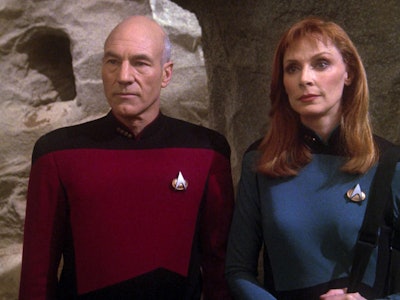
Why do so many Star Trek aliens look like humans? The real-world explanation is that way back in 1964, Gene Roddenberry said the format of Star Trek would focus on stories that took place on “parallel worlds.” This didn’t mean Trek was an alternate universe-hopping show, but that allegorically, the people encountered by the Enterprise were humanoid, thus making the stories easier to write and understand (and, from a budget perspective, easier to make). But there’s an in-universe explanation for this, too.
In 1993, Star Trek: The Next Generation devoted an episode to answering this big question. And now, 31 years later, Star Trek: Discovery is doubling down with a Season 5 storyline that serves as a direct sequel to that story. Here’s what this means and why it matters. Spoilers ahead for Star Trek: Discovery Season 5, Episodes 1 and 2.
The return of Star Trek’s Progenitors
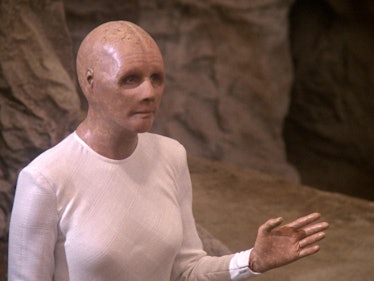
The Progenitor’s message in the Next Generation episode “The Chase.”
At the end of Discovery Season 5, Episode 1, “Red Directive,” we learn that the data the crew has been assigned to protect is connected to discoveries made by a Romulan scientist in the year 2369. Season 5 happens roughly 820 years after that date, but as Kovich (David Cronenberg) tells Captain Burnham (Sonequa Martin-Green), this information has been kept hidden for centuries. Why?
Well, in “The Chase,” Picard, Crusher, and the Enterprise-D crew — along with representatives from the Cardassians, Klingons, and Romulans — discovered an ancient message coded within DNA that revealed everyone descended from the same ancient aliens. The Progenitors, as their message explains, “...seeded the primordial oceans of many worlds, where life was in its infancy. The seed codes directed your evolution toward a physical form resembling ours.”
Captain Burnham is floored by this information, which makes sense since she’s originally from the 23rd century, and her pre-time travel adventures in Starfleet predate Picard’s by about 100 years. But Burnham’s ignorance of the Progenitors isn’t because she and the Discovery crew are time travelers. There’s another reason why this has all been classified.
Discovery’s new God-mode tech
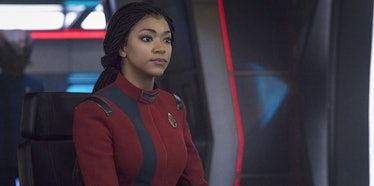
Captain Burnham (Sonequa Martin-Green) is racing to find the most powerful Trek tech of all time.
The fact that most humanoid-looking life in Star Trek descended from an ancient alien species isn’t a new revelation to longtime Trek fans. Even Original Series episodes “Return to Tomorrow” and “The Paradise Syndrom” hinted that several species originated thanks to some kind of organized panspermia . What is new is that the technology the Progenitors used to create life on thousands of worlds has been found.
In Discovery’s “Red Directive,” the journal left by the Romulan scientist is just the first piece of the puzzle. The larger mission is to find the technology the Progenitors developed millions of years ago, and so Discovery has revealed the most powerful technology in all of Trek canon to date. In The Wrath of Khan , we got the Genesis Device , a tech capable of instantly terraforming planets. In Voyager’s “Year of Hell,” the Kremin weapon ship pushed entire planets out of the spacetime continuum, altering history in the blink of an eye.
But those examples of super-tech were unstable. What’s interesting about the ancient Progenitor tech is that it obviously works . Discovery’s imperative to find the tech is classic Trek: if the ability to seed life on a planetary scale falls into the wrong hands, the galaxy could be changed forever. In the grand tradition of Star Trek, the biggest superweapons aren’t planet-destroying superweapons, but something that could redefine and rewrite life itself.
Star Trek: Discovery Season 5 airs on Paramount+.
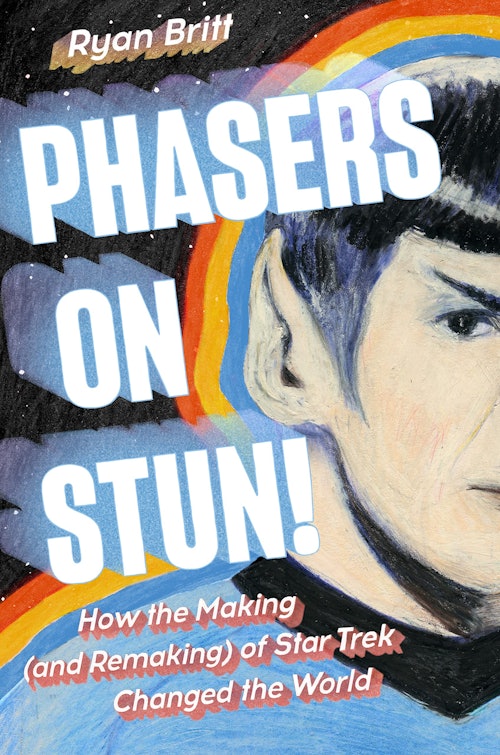
Ryan Britt's new book on the history of Star Trek's biggest changes. From the '60s show to the movies to 'TNG,' to 'Discovery,' 'Picard,' Strange New Worlds,' and beyond!
- Science Fiction
The Future of ‘Star Trek’: From ‘Starfleet Academy’ to New Movies and Michelle Yeoh, How the 58-Year-Old Franchise Is Planning for the Next Generation of Fans
“I can’t believe I get to play the captain of the Enterprise.”
“Strange New Worlds” is the 12th “Star Trek” TV show since the original series debuted on NBC in 1966, introducing Gene Roddenberry’s vision of a hopeful future for humanity. In the 58 years since, the “Star Trek” galaxy has logged 900 television episodes and 13 feature films, amounting to 668 hours — nearly 28 days — of content to date. Even compared with “Star Wars” and the Marvel Cinematic Universe, “Star Trek” stands as the only storytelling venture to deliver a single narrative experience for this long across TV and film.
In other words, “Star Trek” is not just a franchise. As Alex Kurtzman , who oversees all “Star Trek” TV production, puts it, “‘Star Trek’ is an institution.”
Without a steady infusion of new blood, though, institutions have a way of fading into oblivion (see soap operas, MySpace, Blockbuster Video). To keep “Star Trek” thriving has meant charting a precarious course to satisfy the fans who have fueled it for decades while also discovering innovative ways to get new audiences on board.
“Doing ‘Star Trek’ means that you have to deliver something that’s entirely familiar and entirely fresh at the same time,” Kurtzman says.
The franchise has certainly weathered its share of fallow periods, most recently after “Nemesis” bombed in theaters in 2002 and UPN canceled “Enterprise” in 2005. It took 12 years for “Star Trek” to return to television with the premiere of “Discovery” in 2017; since then, however, there has been more “Star Trek” on TV than ever: The adventure series “Strange New Worlds,” the animated comedy “Lower Decks” and the kids series “Prodigy” are all in various stages of production, and the serialized thriller “Picard” concluded last year, when it ranked, along with “Strange New Worlds,” among Nielsen’s 10 most-watched streaming original series for multiple weeks. Nearly one in five Paramount+ subscribers in the U.S. is watching at least one “Star Trek” series, according to the company, and more than 50% of fans watching one of the new “Trek” shows also watch at least two others. The new shows air in 200 international markets and are dubbed into 35 languages. As “Discovery” launches its fifth and final season in April, “Star Trek” is in many ways stronger than it’s ever been.
“’Star Trek’s fans have kept it alive more times than seems possible,” says Eugene Roddenberry, Jr., who executive produces the TV series through Roddenberry Entertainment. “While many shows rightfully thank their fans for supporting them, we literally wouldn’t be here without them.”
But the depth of fan devotion to “Star Trek” also belies a curious paradox about its enduring success: “It’s not the largest fan base,” says Akiva Goldsman, “Strange New Worlds” executive producer and co-showrunner. “It’s not ‘Star Wars.’ It’s certainly not Marvel.”
When J.J. Abrams rebooted “Star Trek” in 2009 — with Chris Pine, Zachary Quinto and Zoe Saldaña playing Kirk, Spock and Uhura — the movie grossed more than any previous “Star Trek” film by a comfortable margin. But neither that film nor its two sequels broke $500 million in global grosses, a hurdle every other top-tier franchise can clear without breaking a sweat.
There’s also the fact that “Star Trek” fans are aging. I ask “The Next Generation” star Jonathan Frakes, who’s acted in or directed more versions of “Star Trek” than any other person alive, how often he meets fans for whom the new “Star Trek” shows are their first. “Of the fans who come to talk to me, I would say very, very few,” he says. “‘Star Trek’ fans, as we know, are very, very, very loyal — and not very young.”
As Stapf puts it: “There’s a tried and true ‘Trek’ fan that is probably going to come to every ‘Star Trek,’ no matter what it is — and we want to expand the universe.”
Every single person I spoke to for this story talked about “Star Trek” with a joyful earnestness as rare in the industry as (nerd alert) a Klingon pacifist.
“When I’m meeting fans, sometimes they’re coming to be confirmed, like I’m kind of a priest,” Ethan Peck says during a break in filming on the “Strange New Worlds” set. He’s in full Spock regalia — pointy ears, severe eyebrows, bowl haircut — and when asked about his earliest memories of “Star Trek,” he stares off into space in what looks like Vulcan contemplation. “I remember being on the playground in second or third grade and doing the Vulcan salute, not really knowing where it came from,” he says. “When I thought of ‘Star Trek,’ I thought of Spock. And now I’m him. It’s crazy.”
To love “Star Trek” is to love abstruse science and cowboy diplomacy, complex moral dilemmas and questions about the meaning of existence. “It’s ultimately a show with the most amazing vision of optimism, I think, ever put on-screen in science fiction,” says Kurtzman, who is 50. “All you need is two minutes on the news to feel hopeless now. ‘Star Trek’ is honestly the best balm you could ever hope for.”
I’m getting a tour of the USS Enterprise from Scotty — or, rather, “Strange New World” production designer Jonathan Lee, who is gushing in his native Scottish burr as we step into the starship’s transporter room. “I got such a buzzer from doing this, I can’t tell you,” he says. “I actually designed four versions of it.”
Lee is especially proud of the walkway he created to run behind the transporter pads — an innovation that allows the production to shoot the characters from a brand-new set of angles as they beam up from a far-flung planet. It’s one of the countless ways that this show has been engineered to be as cinematic as possible, part of Kurtzman’s overall vision to make “Star Trek” on TV feel like “a movie every week.”
Kurtzman’s tenure with “Star Trek” began with co-writing the screenplay for Abrams’ 2009 movie, which was suffused with a fast-paced visual style that was new to the franchise. When CBS Studios approached Kurtzman in the mid-2010s about bringing “Star Trek” back to TV, he knew instinctively that it needed to be just as exciting as that film.
“The scope was so much different than anything we had ever done on ‘Next Gen,’” says Frakes, who’s helmed two feature films with the “Next Generation” cast and directed episodes of almost every live-action “Trek” TV series, including “Discovery” and “Strange New Worlds.” “Every department has the resources to create.”
A new science lab set for Season 3, for example, boasts a transparent floor atop a four-foot pool of water that swirls underneath the central workbench, and the surrounding walls sport a half dozen viewscreens with live schematics custom designed by a six-person team. “I like being able to paint on a really big canvas,” Kurtzman says. “The biggest challenge is always making sure that no matter how big something gets, you’re never losing focus on that tiny little emotional story.”
At this point, is there a genre that “Strange New Worlds” can’t do? “As long as we’re in storytelling that is cogent and sure handed, I’m not sure there is,” Goldsman says with an impish smile. “Could it do Muppets? Sure. Could it do black and white, silent, slapstick? Maybe!”
This approach is also meant to appeal to people who might want to watch “Star Trek” but regard those 668 hours of backstory as an insurmountable burden. “You shouldn’t have to watch a ‘previously on’ to follow our show,” Myers says.
To achieve so many hairpin shifts in tone and setting while maintaining Kurtzman’s cinematic mandate, “Strange New Worlds” has embraced one of the newest innovations in visual effects: virtual production. First popularized on the “Star Wars” series “The Mandalorian,” the technology — called the AR wall — involves a towering circular partition of LED screens projecting a highly detailed, computer-generated backdrop. Rather than act against a greenscreen, the actors can see whatever fantastical surroundings their characters are inhabiting, lending a richer level of verisimilitude to the show.
But there is a catch. While the technology is calibrated to maintain a proper sense of three-dimensional perspective through the camera lens, it can be a bit dizzying for anyone standing on the set. “The images on the walls start to move in a way that makes no sense,” says Mount. “You end up having to focus on something that’s right in front of you so you don’t fall down.”
And yet, even as he’s talking about it, Mount can’t help but break into a boyish grin. “Sometimes we call it the holodeck,” he says. In fact, the pathway to the AR wall on the set is dotted with posters of the virtual reality room from “The Next Generation” and the words “Enter Holodeck” in a classic “Trek” font.
“I want to take one of those home with me,” Peck says. Does the AR wall also affect him? “I don’t really get disoriented by it. Spock would not get ill, so I’m Method acting.”
I’m on the set of the “Star Trek” TV movie “Section 31,” seated in an opulent nightclub with a view of a brilliant, swirling nebula, watching Yeoh rehearse with director Olatunde Osunsanmi and her castmates. Originally, the project was announced as a TV series centered on Philippa Georgiou, the semi-reformed tyrant Yeoh originated on “Discovery.” But between COVID delays and the phenomenon of “Everything Everywhere All at Once,” there wasn’t room in the veteran actress’s schedule to fit a season of television. Yeoh was undaunted.
“We’d never let go of her,” she says of her character. “I was just blown away by all the different things I could do with her. Honestly, it was like, ‘Let’s just get it done, because I believe in this.’”
If that means nothing to you, don’t worry: The enormity of the revelation that Garrett is being brought back is meant only for fans. If you don’t know who the character is, you’re not missing anything.
“It was always my goal to deliver an entertaining experience that is true to the universe but appeals to newcomers,” says screenwriter Craig Sweeny. “I wanted a low barrier of entry so that anybody could enjoy it.”
Nevertheless, including Garrett on the show is exactly the kind of gasp-worthy detail meant to flood “Star Trek” fans with geeky good feeling.
“You cannot create new fans to the exclusion of old fans,” Kurtzman says. “You must serve your primary fan base first and you must keep them happy. That is one of the most important steps to building new fans.”
On its face, that maxim would make “Section 31” a genuine risk. The titular black-ops organization has been controversial with “Star Trek” fans since it was introduced in the 1990s. “The concept is almost antagonistic to some of the values of ‘Star Trek,’” Sweeny says. But he still saw “Section 31” as an opportunity to broaden what a “Star Trek” project could be while embracing the radical inclusivity at the heart of the franchise’s appeal.
“Famously, there’s a spot for everybody in Roddenberry’s utopia, so I was like, ‘Well, who would be the people who don’t quite fit in?’” he says. “I didn’t want to make the John le Carré version, where you’re in the headquarters and it’s backbiting and shades of gray. I wanted to do the people who were at the edges, out in the field. These are not people who necessarily work together the way you would see on a ‘Star Trek’ bridge.”
For Osunsanmi, who grew up watching “The Next Generation” with his father, it boils down to a simple question: “Is it putting good into the world?” he asks. “Are these characters ultimately putting good into the world? And, taking a step back, are we putting good into the world? Are we inspiring humans watching this to be good? That’s for me what I’ve always admired about ‘Star Trek.’”
Should “Section 31” prove successful, Yeoh says she’s game for a sequel. And Kurtzman is already eyeing more opportunities for TV movies, including a possible follow-up to “Picard.” The franchise’s gung-ho sojourn into streaming movies, however, stands in awkward contrast to the persistent difficulty Paramount Pictures and Abrams’ production company Bad Robot have had making a feature film following 2016’s “Star Trek Beyond” — the longest theaters have gone without a “Star Trek” movie since Paramount started making them.
First, a movie reuniting Pine’s Capt. Kirk with his late father — played in the 2009 “Star Trek” by Chris Hemsworth — fell apart in 2018. Around the same time, Quentin Tarantino publicly flirted with, then walked away from, directing a “Star Trek” movie with a 1930s gangster backdrop. Noah Hawley was well into preproduction on a “Star Trek” movie with a brand-new cast, until then-studio chief Emma Watts abruptly shelved it in 2020. And four months after Abrams announced at Paramount’s 2022 shareholders meeting that his 2009 cast would return for a movie directed by Matt Shakman (“WandaVision”), Shakman left the project to make “The Fantastic Four” for Marvel. (It probably didn’t help that none of the cast had been approached before Abrams made his announcement.)
The studio still intends to make what it’s dubbed the “final chapter” for the Pine-Quinto-Saldaña cast, and Steve Yockey (“The Flight Attendant”) is writing a new draft of the script. Even further along is another prospective “Star Trek” film written by Seth Grahame-Smith (“Abraham Lincoln: Vampire Hunter”) and to be directed by Toby Haynes (“Andor,” “Black Mirror: USS Callister”) that studio insiders say is on track to start preproduction by the end of the year. That project will serve as an origin story of sorts for the main timeline of the entire franchise. In both cases, the studio is said to be focused on rightsizing the budgets to fit within the clear box office ceiling for “Star Trek” feature films.
Far from complaining, everyone seems to relish the challenge. Visual effects supervisor Jason Zimmerman says that “working with Alex, the references are always at least $100 million movies, if not more, so we just kind of reverse engineer how do we do that without having to spend the same amount of money and time.”
The workload doesn’t seem to faze him either. “Visual effects people are a big, big ‘Star Trek’ fandom,” he says. “You naturally just get all these people who go a little bit above and beyond, and you can’t trade that for anything.”
In one of Kurtzman’s several production offices in Toronto, he and production designer Matthew Davies are scrutinizing a series of concept drawings for the newest “Star Trek” show, “Starfleet Academy.” A bit earlier, they showed me their plans for the series’ central academic atrium, a sprawling, two-story structure that will include a mess hall, amphitheater, trees, catwalks, multiple classrooms and a striking view of the Golden Gate Bridge in a single, contiguous space. To fit it all, they plan to use every inch of Pinewood Toronto’s 45,900 square foot soundstage, the largest in Canada.
But this is a “Star Trek” show, so there do need to be starships, and Kurtzman is discussing with Davies about how one of them should look. The issue is that “Starfleet Academy” is set in the 32nd century, an era so far into the future Kurtzman and his team need to invent much of its design language.
“For me, this design is almost too Klingon,” Kurtzman says. “I want to see the outline and instinctively, on a blink, recognize it as a Federation ship.”
The time period was first introduced on Season 3 of “Discovery,” when the lead character, Michael Burnham (Sonequa Martin-Green), transported the namesake starship and its crew there from the 23rd century. “It was exciting, because every time we would make a decision, we would say, ‘And now that’s canon,’” says Martin-Green.
“We listened to a lot of it,” Kurtzman says. “I think I’ve been able to separate the toxic fandom from really true fans who love ‘Star Trek’ and want you to hear what they have to say about what they would like to see.”
By Season 2, the “Discovery” writers pivoted from its dour, war-torn first season and sent the show on its trajectory 900-plus years into the future. “We had to be very aware of making sure that Spock was in the right place and that Burnham’s existence was explained properly, because she was never mentioned in the original series,” says executive producer and showrunner Michelle Paradise. “What was fun about jumping into the future is that it was very much fresh snow.”
That freedom affords “Starfleet Academy” far more creative latitude while also dramatically reducing how much the show’s target audience of tweens and teens needs to know about “Star Trek” before watching — which puts them on the same footing as the students depicted in the show. “These are kids who’ve never had a red alert before,” Noga Landau, executive producer and co-showrunner, says. “They never had to operate a transporter or be in a phaser fight.”
In the “Starfleet Academy” writers’ room in Secret Hideout’s Santa Monica offices, Kurtzman tells the staff — a mix of “Star Trek” die-hards, part-time fans and total newbies — that he wants to take a 30,000-foot view for a moment. “I think we need to ground in science more throughout the show,” he says, a giant framed photograph of Spock ears just over his shoulder. “The kids need to use science more to solve problems.”
Immediately, one of the writers brightens. “Are you saying we can amp up the techno-babble?” she says. “I’m just excited I get to use my computer science degree.”
After they break for lunch, Kurtzman is asked how much longer he plans to keep making “Star Trek.”
“The minute I fall out of love with it is the minute that it’s not for me anymore. I’m not there yet,” he says. “To be able to build in this universe to tell stories that are fundamentally about optimism and a better future at a time when the world seems to be falling apart — it’s a really powerful place to live every day.”
More From Our Brands
Jon stewart calls out u.s. support of israel amid solar eclipse frenzy, two restored barns add to the bucolic charm of this $12.5 million hamptons farmhouse, uconn hoops spending pays off with second straight ncaa title, the best loofahs and body scrubbers, according to dermatologists, fallout to get early full-season drop on amazon — find out when, verify it's you, please log in.
The Star Trek Alien You Are Based On Your Zodiac
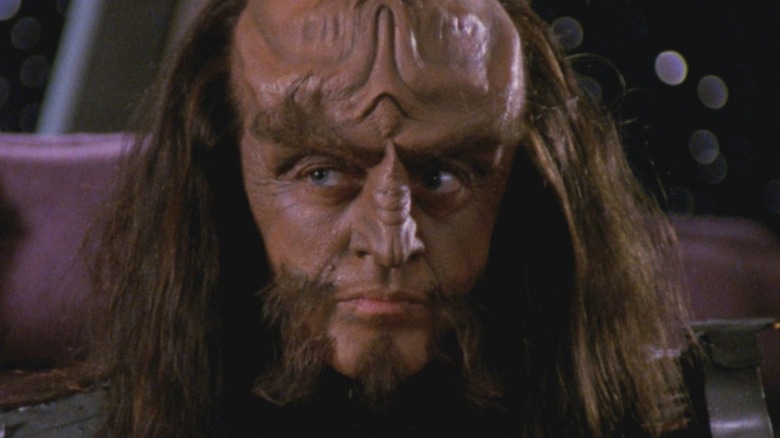
The "Star Trek" franchise is known for many things, from its theme songs to its iconic starships to its well-known characters like Captains Kirk, Picard, and Janeway. But the series also includes some of the most famous alien races in all of science fiction: species and cultures who have become as complex and fleshed out as our own human race.
The original "Star Trek" introduced audiences to the Vulcans, Klingons, and Romulans. "The Next Generation" turned the Klingons into one of the most complicated peoples in all of sci-fi, and added the Ferengi, the Borg, the Bajorans, and the Cardassians. "Deep Space Nine" gave history, culture, and subtlety to the Cardassians, Bajorans and Ferengi, and brought the Jem'Hadar and the Vorta to audiences, while "Enterprise" gave much-needed nuance to the Vulcans, Andorians, and even Tellarites. New shows like "Discovery," "Prodigy," and "Picard" continue to add to the franchise's long list of incredible alien races.
What makes many of the cultures in "Star Trek" so fascinating, and so unique among sci-fi properties, is that each one has its own distinctive characteristics and traits, strengths and weaknesses. This reminds us very much of the signs of the zodiac: unique personalities with their own qualities and even singular peculiarities. So we've collected info on the most well-known races in order to give you some insight into yourself. Here is a list to see which alien race in "Star Trek" you are, based on your zodiac sign.
Aries: Andorian
We knew little about Andorians when we first met them in the original series episode "Journey To Babel." But when they showed up again on "Star Trek: Enterprise" some 35 years later we got a much better look at them. Fiery and brash, driven by their feelings, Andorians are a stark contrast to their rival Vulcans, who are emotionless and logical. The blue-skinned, antennaed Andorians could be said to be volatile, but it's not because they're overly emotional — it comes from their deep sense of self-assuredness. This is why they are the Aries on our list: confident and bold, they do nothing in half measures, and make no apologies for it.
Said to be one of the more distrustful zodiac signs , the Aries — like the Andorians — are natural skeptics, never too eager to take anything at face value, nor people at their word. Andorians have taken this a bit further, but that's only because their early pre-Federation enemies, the Vulcans, gave them good cause to question their motives and actions. But Andorians are also loyal, making them good allies, as Commander Shran proved so many times on "Enterprise." It's also why they made the perfect alien race to help found the United Federation of Planets, because once an Aries can sit down and hash out their issues with others, they are great friends to have around.
Taurus: Bajoran
Sometimes described as introverted, it might be better to say that a Taurus is insular; they prefer to keep to themselves, though are not entirely averse to engaging with a greater community. Because more than most, the Taurus likes things the way they are. While not against progress, they find change to be an uncomfortable upheaval, and would prefer the warmth and comfort of what they know over the excitement of what is new and compelling. They embody stability and steadiness, a rock in the ever-changing wood, a solid oak in a raging storm. Dependable, grounded, and pragmatic, the Taurus is fiercely self-sufficient, and doesn't like to rely on others. They are also best aligned with the Bajorans, seen often in "Star Trek: Deep Space Nine."
A deeply spiritual people, the Bajorans are motivated by a desire to preserve their way of life. Even after the devastation they endured during the Occupation, the Bajorans were still split over whether Federation membership was right for them. Many felt they were better off on their own, but some felt it was the best, most realistic option for their continued way of life. Both sides were driven by a desire to see their people thrive. Isolated and independent, they like to do things for themselves, and stay the way they are. They don't necessarily need fancy technology, or powerful allies ... but they are also willing to acknowledge that in the world of galactic affairs, going it alone may not always be possible.
Gemini: Cardassian
A Gemini loves to talk and won't stop, because they love the sound of their own voice, and think they are an expert on every subject (and sometimes they are). Intelligent and clever, they are incredibly charismatic too, which can balance out their loquaciousness and charm those around them, putting people at ease despite their sometimes off-putting quirks. Gul Dukat, despite his more nefarious personality, may be the quintessential Cardassian, the endlessly talkative, devilishly charming former Prefect of Bajor, who loves using arguing as a means of courting in true Gemini fashion.
Cardassians share so many traits with the twin sign it's tempting to think that "Star Trek" writers may have been looking at their astrological chart for inspiration when crafting the alien race. Geminis are terrific communicators and good listeners, but they are also shrewd and perceptive; they can see through lies and deception, and judge a person's character with but a fleeting glance. If their enemy is bluffing they'll know; if an ally is going to double cross them, they'll do it first. But they don't keep friends easily, as their attention is tough to hold. They are captivated by anything new and interesting that enters their sightline, whether that be a bright green bottle of Kanar they can devour or a resource-rich alien planet they can conquer.
Cancer: Betazoid
Described as an "emotional packmule," those born under the sign of Cancer are highly sensitive and empathetic. They have a caring nature that comes naturally to them. They are helpers and do-gooders, and look to improve the world around them through whatever means they can. Most often this takes the form of being a trusted friend and counsel to those who need help. But they also carry great sadness, whether because of trauma in their own past, or because their empathetic nature sees them absorb other people's problems so readily. With all this in mind, it makes sense that the Betazoid people are the alien race in "Star Trek" that best embodies the Cancer.
While the Enterprise's resident counselor, Deanna Troi , is the one we're most familiar with, we've met several others, including Lwaxana Troi, Tam Elbrun, and Lon Suder. All were very different people, but all were highly sensitive to the moods of others. They all had a deep sense of caring for those around them, even the proven killer Lon Suder, who, after he got help, desperately wanted to do something — anything — to assist his ship. Elbrun, meanwhile, was a misunderstood Betazoid from the "TNG" episode "Tin Man" who not only gave comfort but sought it as well, another common trait of the Cancer sign. Cancers feel everything, and with their telepathic abilities, this becomes more literal than most for Betazoids.
Leo: Ferengi
Leo , the sign of the lion, can be described as a vibrant star, an entertainer with a theatrical flare. They are charismatic and have a way with words, often dazzling others with their wit and sagacity. Confident and overzealous, they have a big ego, and are always looking for recognition. But most of all, Leos thrive on ambition and wish to climb the ladder of success; growth drives them, expansion motivates them. The Ferengi are the alien race in "Star Trek" that screams Leo, obsessed with increasing their individual empires, growing their businesses and expanding their profits. They are driven by a will to succeed, and use their charm and confidence to sway others in their circle to help them climb that ladder.
Who in all of "Star Trek" but the Ferengi could this describe? The Ferengi don't just love acquiring, they love flaunting — whether it's Gaila boasting of owning his own moon, Quark's colorful outfits, Brunt's regal gait, or the Nagus who takes being ostentatious to the extreme. Ferengis love to show off, always want to be the center of attention, and have the big personality to match their talk. Though they can't always back it up physically, they're masters of words, making them the perfect con-men. At times though, as with Quark, Pel, and Dr. Reyga, they've also shown themselves to be good-hearted and valuable friends.
Scorpio: The Borg
Cold and steely-eyed, the Scorpio is a misunderstood sign, often said to be untrustworthy, unscrupulous, and even soulless. But their dark nature can be attributed mostly to their stoic personality and insular nature. Scorpios don't make friends, they absorb others into their orbit through sheer force of will, with their enigmatic nature often bringing others close out of sheer curiosity. Endlessly fascinated by everything in their environment, they see those around them as little more than science experiments, and are always looking to poke and prod beneath the surface to understand what makes them tick. Secretive, when they want answers they'll do whatever it takes to get them, using words like a surgical instrument to peer into your soul.
There can be no alien that resembles the Scorpio more than the Borg, the collective hive-mind race of cybernetic beings that Captain Janeway once indeed likened to the scorpion itself, unable to avoid its true nature as a predator. With no individuality, personality and morals have no meaning to the Borg, who act with a singular will to dominate and assimilate all life within their field of vision. They see others as raw material to add to their perfection, and will do whatever it takes to acquire them for their own ends. They experiment on those they collect, peer inside (literally) and extract from them what they need. They've attempted to find common ground with the Federation on unique occasions, but can never be trusted.
Libra: Trill
A walking puzzle, the Libra is a constant stream of contradictions, "simultaneously extroverted and introverted, strategic and spontaneous, focused and intuitive," according to the zodiac experts at Costar Astrology. They are a wondrous mixture, a perfect blend, and swirling sea of different personalities, and because of this can often take a long time to understand themselves. This is as true of the symbiont Trills as anyone we've ever seen in "Star Trek," a race of beings who are quite literally a combination of many people. The Trill exist as a dual entity, the symbiont and the host, with the symbiont merging its personality with its host, and passing from person to person over the course of hundreds of years. When we met Jadzia Dax in "Deep Space Nine" she had already lived many different lives, men and women, all with vastly different personalities. It took her quite a while to settle into who she really was.
Adira Tal, the Trill symbiont (Tal) trapped in a non-Trill host (Adira), was even more unsure, still seeing visions of her previous host and lover, the mysterious Gray. Insightful and wise, thanks to their centuries of life and many experiences, Trills are the embodiment of the charming and opinionated Libra. Even the criminal Trill Verad showed all the traits of the Libra, so desperate for a symbiont because he could not bear to be alone.
Virgo: Vorta
Virgos are peculiar and particular people. They are perfectionists, are obsessive about details and live their lives in an orderly fashion. They often make good assistants and helpers because they are devoted to caring for others and servicing the needs of their closest friends and family. Some more dominant signs like Aries or Scorpio view the Virgo as weak, but others like the Taurus or Cancer admire the Virgo for their selflessness and lack of self-centeredness, as they are rarely motivated by their own needs. Despite being extremely intelligent, they can struggle with expressing their thoughts, not because they are inarticulate but because they themselves find it hard to understand what they are feeling.
Likewise, the Vorta, who sit as the second most powerful race within the Dominion, have much in common with the Virgo. Vorta are particular and uptight and want everything just so. Orderly and efficient, they are driven only to serve the Founders, leaders of the galactic power in the Gamma Quadrant. Smart, shrewd, and downright cunning, they too can find it challenging to communicate with other peoples because — as a race genetically modified by the Changelings — they weren't left equipped with many of the traits of most solids, like emotional awareness, or even taste buds for that matter.
Capricorn: Vulcan
One of the first alien races ever seen in "Star Trek," the Vulcans are most known for their repression of emotion and their logical nature. But they are also noble and dutiful, motivated by a sense of moral and ethical responsibility. This makes their race akin to the Capricorn , a selfless, zen philosopher who is never one to seek attention. The Capricorn is also ambitious, with a keen awareness of what is needed to achieve their goals. Their relatively small ego does not mean they are without pride, and like Vulcans, who hide it well, they can often be bruised by attacks on their abilities. Vulcans and Capricorns both cannot tolerate it when their better nature is taken advantage of.
As we saw clearly throughout the franchise, but most notably on "Star Trek: Enterprise," Vulcans can often have a more transparent sense of superiority , believing that their own ways are better than others. Everyone should follow their example, and while they respect others' beliefs and unique way of doing things — appreciating diversity — it's sometimes hard to accept that their way might stand some improvement. But of course, the biggest trait that is shared between Capricorns and Vulcans is their lack of emotion, or rather repression of it. Both feel that emotions are an unnecessary impediment to their lofty aspirations.
Sagittarius: Klingon
A Sagittarius is loud and opinionated, led by raw emotions and fierce personalities that are difficult to contain. Still, the sign is also marked by a cleverness and wisdom that most do not expect based on their rough exterior. At times, the Sagittarius can be downright philosophical and lyrical, making the classic metaphor of "warrior-poet" quite an apt description for them. They fight hard for the things that they believe in, and live their truth as ruthlessly as they might swing a blade. For the Klingon, however, that is no metaphor.
An explorer of the heart, a rider of the waves of passion, a Klingon swings their bat'leth as an extension of their spirit the way a Sagittarius might use their booming voice and outsized presence. Restless and eager, the Klingons find no greater challenge than the journey inward, but find no greater pleasure than in proving their outward strength. Klingons are a polarizing people who, like the Sagittarius, evoke strong feelings in those around them. One either truly understands the warrior race, admiring their passion of life and lust for glory, or they find it hard to even tolerate them, put off by their brusque nature and love of combat. There is no in-between for most when it comes to dealing with Klingons and Sagittariuses.
Pisces: Ocampan
It's said that those born under the sign of Pisces are "both five and 50 years old" at the same time, meaning they have both a child-like innocence and a world-weary wisdom. It may seem contradictory, but to a Pisces it's an ethereal balance that gives them a unique perspective. Able to recognize both the troubles and the wonders that surround them, they are able to get more out of life than most thanks to their special outlook. A Pisces' dreamy personality sees all possibilities, which often makes them boundlessly optimistic, believing strongly in the beauty of existence and all they can accomplish, even in cases when it borders on pure fantasy.
Though we've only met a handful of them, the Ocampans — who live their entire lives in just nine Earth years — are the Pisces of "Star Trek." Their shortened lifespans lead them to be, quite literally, young and old at the same time. Yet despite their relative lack of worldly experience, they have a kind of innocent wisdom, like a child sage, and a positive, if sometimes naive, attitude. The Ocampans shown on "Star Trek: Voyager," particularly Kes, have an adaptable personality that can change like a soft breeze. Ultimately, it's said that a Pisces "wants to dissolve," and that's exactly what a properly enlightened Ocampan does: after their nine-year lifespan ends, they transcend their physical bodies and evolve into another plane of existence.
Aquarius: Romulan
A Romulan can defy conventional description, because like humans, we have seen so many different facets to them. Some Romulans are militant and obsessively close-minded, while others seek enlightenment and wisdom. But all share a deep search for knowledge, and a certain suspicious nature that borders on paranoia. Such attributes are emblematic of the Aquarius , who is always questioning, always skeptical, and always hiding deeper thoughts just under the skin. Duty-bound, Romulans share with the Pisces the fundamental nature of even-handedness: not quite selfless, but a belief in the communal good. Romulans apply this belief ruthlessly, to the advancement of their own people, and at the expense of others.
They have a strict view of the world, too, and cannot tolerate injustices big or small. When they see something that goes against their systems, they will let you know, and hold you to account. Don't ever think that an apology is enough: you may believe that a Romulan forgives and forgets, but like the Aquarius, they hide their grudges deep inside until it comes out when you least expect it.
- More to Explore
- Series & Movies
Published Apr 8, 2024
Star Trek Explorer #11 Delivers A Difficult Encounter Between Captain Shaw and Seven of Nine
The latest issue of Star Trek Explorer hits newsstands tomorrow, featuring interviews with Sonequa Martin-Green, the Hagemans, and more!

StarTrek.com
Tomorrow's release of Star Trek Explorer #11 is here to deliver on all your Star Trek news!
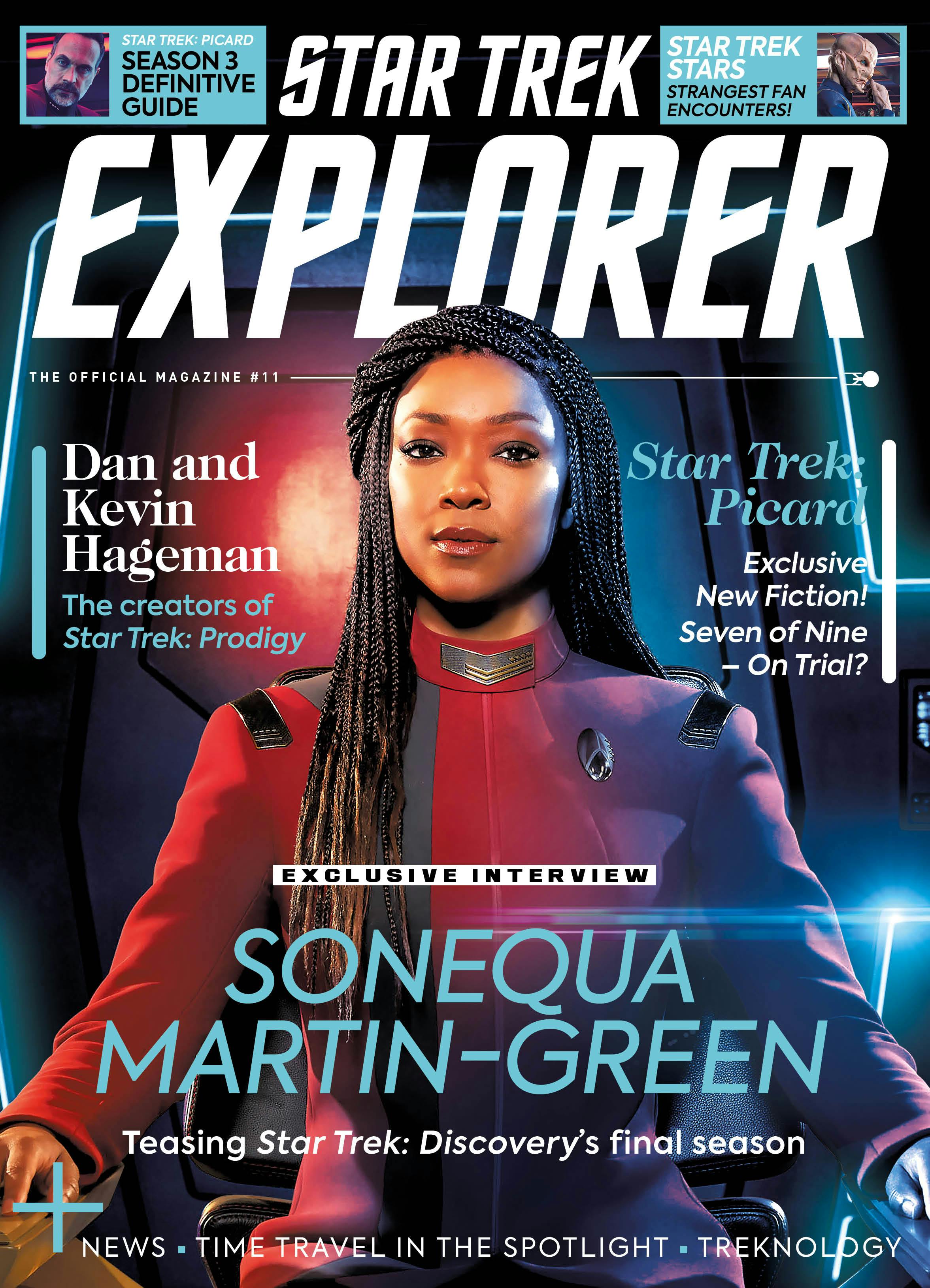
Star Trek Explorer #11 Newsstand Cover
Within the pages of the latest issue of Star Trek Explorer , dive into a handful of exclusive fiction, interviews, and features.
Star Trek Explorer #11 celebrates the final season of Star Trek: Discovery with an exclusive interview with Sonequa Martin-Green. She teases things to come as the series draws to a close, and offers some candid comments on what she hopes the legacy of the show will be.
Elsewhere, the latest issue has an exclusive interview with the Hagemans — creators of Star Trek: Prodigy ! There’s a Star Trek: Picard short story, "Confirmation Bias" by Michael Dismuke, centering on a difficult encounter between Captain Shaw and Seven of Nine aboard the U.S.S. Titan -A. And in David Mack's short story, "Dignified Transfer," it’s a sad mission for Captain Picard. All this and so much more!
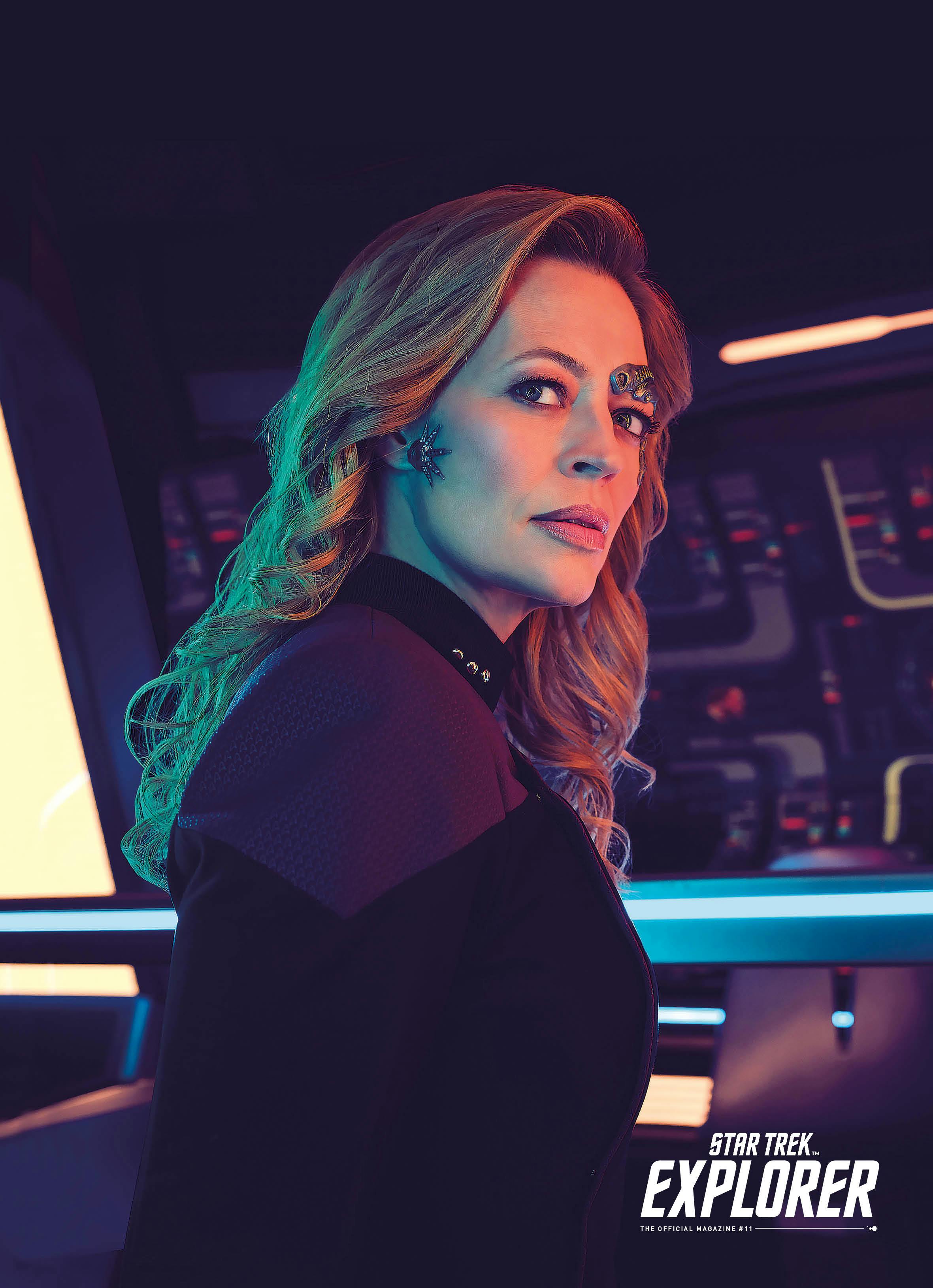
Star Trek Explorer #11 Exclusive Cover
Thanks to our friends at Titan Magazines, we have an exclusive excerpt of the short, "Confirmation Bias" by Michael Dismuke, below!
"Your vessel will be towed to Starbase G-6 where you'll be remanded into the custody of Starfleet Security. From there, a formal tribunal will be formed to decide your fate. If your planet has a judicial system, they have the right to provide for your legal defense. Of course, they might disavow you. I would, since you are such abject losers. If that happens, you'll be provided a replacement from our judge advocate general's office."
Liam Shaw, captain of the U.S.S. Titan -A, finished reading the two captives their rights.
The Usangi'I males sat in two separate but adjacent holding cells in the ship's brig. Blue-hued force fields prevented the duo of criminals from escaping. Shaw couldn't help but think that the portly prisoners, dressed in shiny orange uniforms, resembled tubby worms with the facial features of star-nosed moles – the kind he had caught as a kid back home in Illinois. In a universe shaped by the peculiarities of interstellar evolution, the faces of the Usangi'I captives looked as if a cosmic engineer had attached an otherworldly satellite dish to their snouts. Comprising thirty to forty fleshy, prehensile tendrils that splayed outward like a miniature constellation, their unique facial appendages were endowed with hyper-sensitive neural clusters. These clusters resembled minuscule antenna arrays, fine-tuned to intercept and interpret environmental signals.
The crew of the Titan- A would have preferred to learn about a new, sentient species in a more diplomatic manner. However, the actions of the Usangi'I had changed their status to that of prisoners in the brig rather than of guests on the bridge.
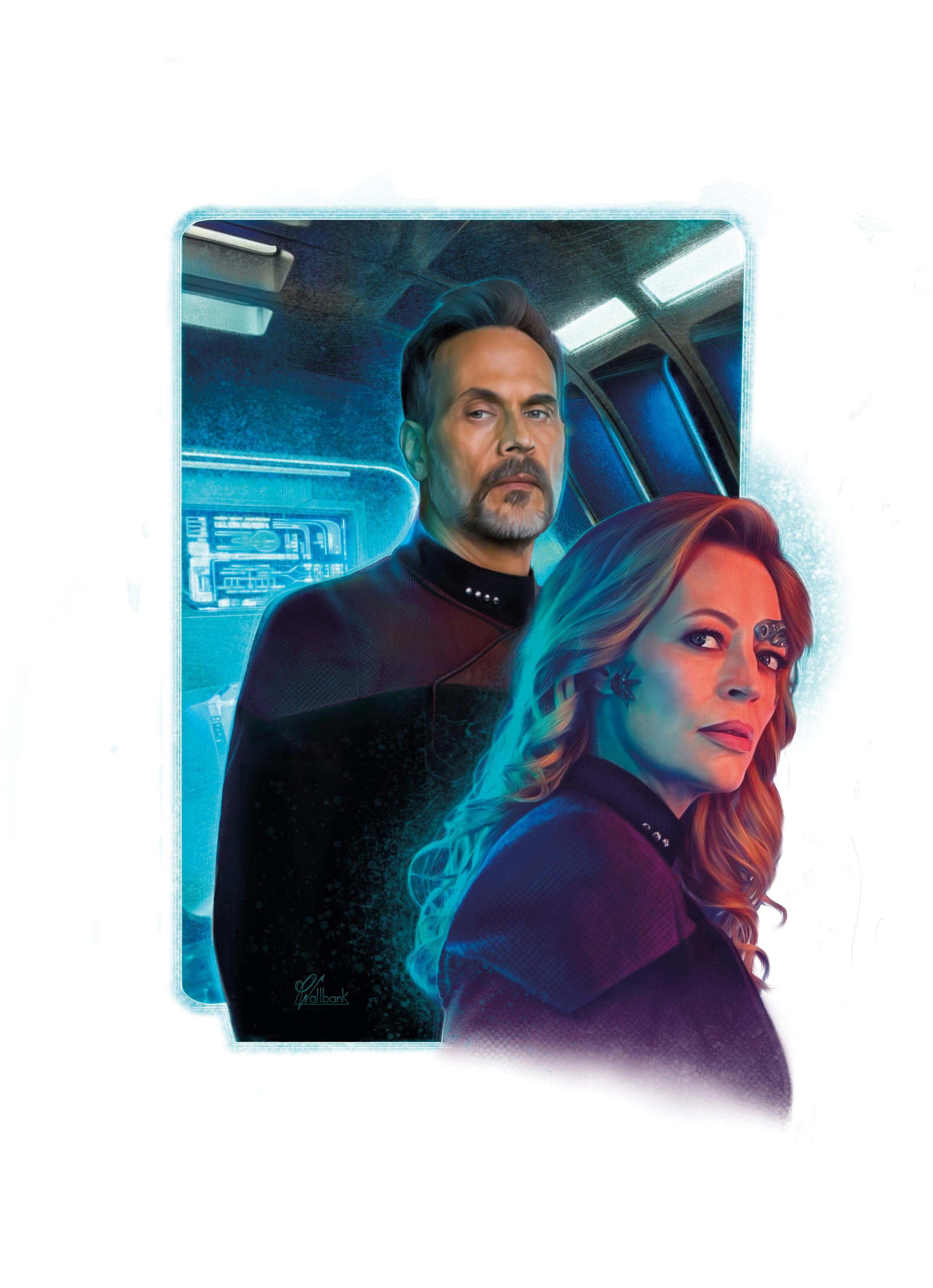
Star Trek Explorer #11 'Confirmation Bias' Artwork
"I'll make sure my chief of security sends you a few holopics of the innards of of a Federation penal colony. I'd hate to keep you in suspense regarding your new digs." Captain Shaw punched a few more notes into the PADD, signed off on the formal charges, then handed it to his first officer. "How many hours until we arrive at G-6, Commander Hansen?"
Seven checked the PADD, added her own sign off, and handed it to one of the two stern-faced security officers that stood guard. "Twelve hours, sir," she responded, silently roiling at the fact that Captain Shaw refused to refer to her by her chosen name.
Though she had thrown off the shackles of the Borg Collective, she had spent approximately half of her life as Seven of Nine, Tertiary Adjunct of Unimatrix Zero One. Once liberated from the Borg, her crewmates aboard U.S.S. Voyager called her by the abbreviated moniker "Seven of Nine" — or just "Seven" — as did her associates in the Fenris Rangers. Shaw's insistence on referring to her by birth name, Annika Hansen, ran deeper than mere accuracy and formality, though the man was a model of procedural compliance. Over the course of weeks, the tonal inflections with which he uttered her name evolved from passive-aggressive jabs to more overt micro-aggressions.
"Captain," Seven asked as they exited the brig into the bustling corridor of the Neo-Constitution -class ship, "may we speak privately?"
"I don't see why not," he responded without making eye contact.
Within short order, Shaw and Seven regrouped to the starship's Observation Lounge. Shaw rounded the conference table and sat down opposite from where Seven stood. He didn't bother to offer a seat to his first officer. With a swipe of the hand, he activated the computer built into the surface of the table and tapped away without looking up. "What can I do for you, Commander Hansen?" He swiped left, making a few selections on the console.
Seven's lips pursed momentarily in a silent symphony of agitation as the captain summoned from the ship's database Vivaldi’s Concerto For Violin And Strings In F Minor. "I would like to address what transpired during our recent contact with the Usangi’I pirates, sir."
Shaw adjusted the volume of the music to his liking. "What exactly would you like me to address?" He sat back, his eyes set for the challenge. "We made first contract with a new species. We quickly determined hostile intent. We uncovered their ruse. Now they sit in the brig awaiting Starfleet justice. Not bad for this crew’s thirty-fifth mission. If you want to take the lead in writing the report, go right ahead."
"I’m not sure you want me to write that report." She offered a moment's hesitation. "Sir."
"Is that so?" The challenge had been accepted. He leaned forward, locking his hands together and resting his elbows on the table. "Pray tell."
You can read the complete short story in Star Trek Explorer #11 on sale April 9. Plus, there's an exclusive interview with Sonequa Martin-Green looking forward to Star Trek: Discovery 's fifth and final season; the Hagemans discuss the importance of Star Trek: Prodigy ; there’s more exclusive short fiction; your definitive guide to Star Trek: Picard Season 3 and much, much more!
Get updates by email.
Stay tuned to StarTrek.com for more details! And be sure to follow @StarTrek on TikTok , Instagram , Facebook , YouTube , and Twitter .
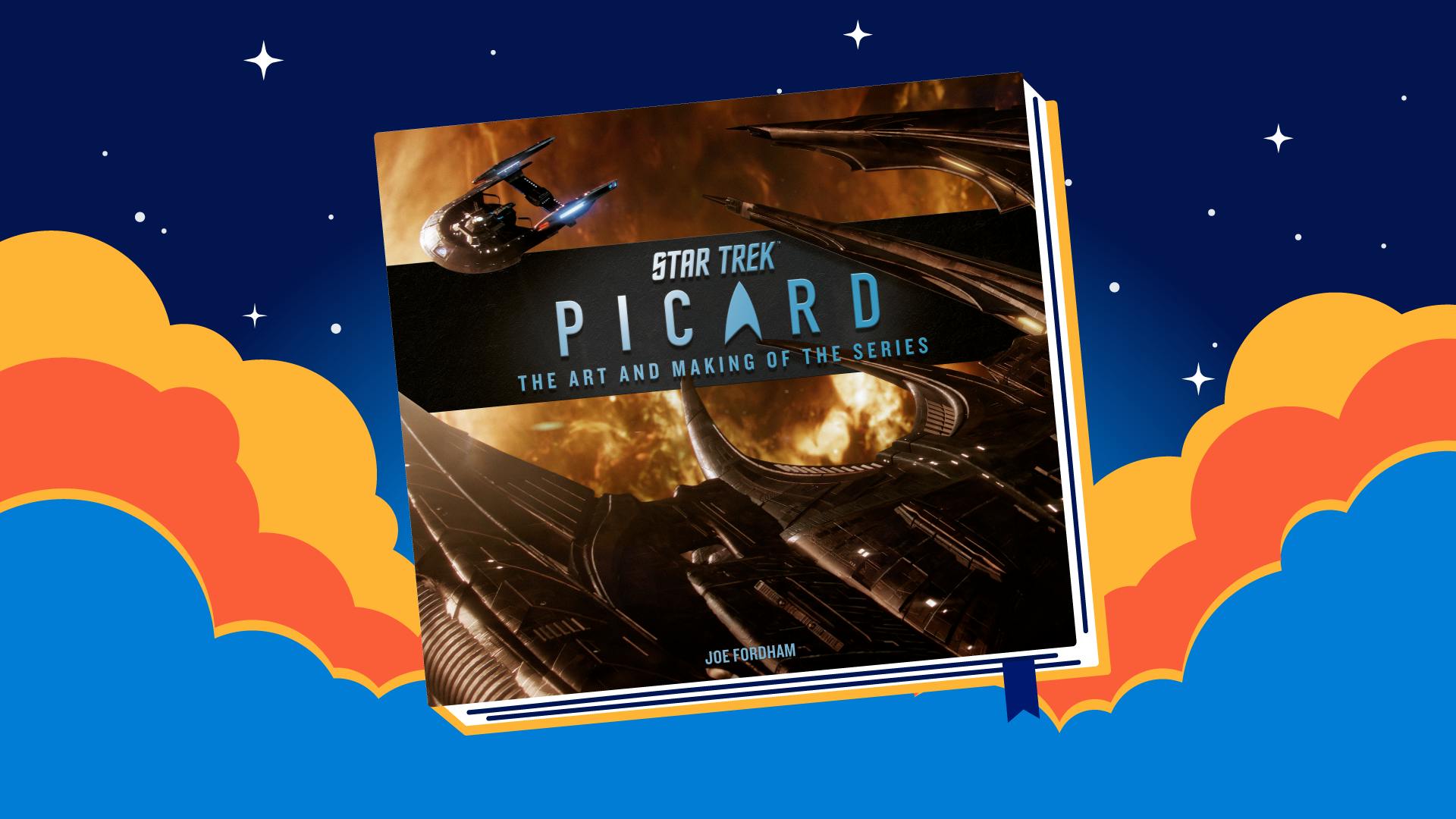
Screen Rant
Who is callum keith rennie star trek: discovery’s captain rayner actor explained.
Renowned science fiction actor Callum Keith Rennie leads the USS Antares as Captain Rayner in Star Trek: Discovery's fifth and final season.
Warning: SPOILERS for Star Trek: Discovery Season 5
- Callum Keith Rennie debuts in Star Trek: Discovery as the Kellerun Captain Rayner.
- Known for his role as Leoben Conoy in Battlestar Galactica, Callum Keith Rennie brings depth and experience to Star Trek: Discovery's final season.
- Rennie's role as Captain Rayner adds connection and nostalgia to Star Trek: Discovery, overlapping with Battlestar Galactica
Accomplished actor Callum Keith Rennie joins the fifth and final season of Star Trek: Discovery . Star Trek: Discovery season 5 sends Captain Michael Burnham (Sonequa Martin-Green) and the USS Discovery on a hunt for an ancient technology with the power to create life itself. Introducing Callum Keith Rennie as Captain Rayner, a strait-laced and commanding character of alien origin , Discovery season 5 sets the stage for a gripping showdown and sends Burnham and the USS Discovery and the USS Antares commander on an epic quest for an ancient treasure.
Perhaps best recognized for his standout roles in Battlestar Galactica and Californication , Callum Keith Rennie joins the Star Trek: Discovery cast for their last adventure, delivering a wealth of experience from earlier genre-defining roles. Rennie’s portrayal of Captain Rayner reportedly promises an intriguing counterpoint to Burnham underscoring Rayner's great potential with a mysterious backstory set to unfold over the course of the show’s fifth season. With the revelatory Captain of the USS Antares looking very much to be a vital – perhaps pivotal – addition to Starfleet’s impressive body of commanding officers, here’s a look at the award-winning Callum Keith Rennie.
Every Upcoming Star Trek Movie & TV Show
Callum keith rennie plays captain rayner in star trek: discovery, captain rayer is callum keith rennie's first appearance in the star trek franchise.
Callum Keith Rennie joins Star Trek: Discovery season 5 as Captain Rayner, the fierce commander of the USS Antares . Driven and dedicated to his mission, Rayner draws distinction between himself and his crew. A member of a little-known species first introduced in Star Trek: Deep Space Nine , Captain Rayner is a Kellerun , and his backstory is crucial to his mission and character. Described as gruff, tough, and intelligent, Rayner is a war hero struggling to acclimate to peace post-Burn, but dedicated to serving the greater good. In search of a hidden, ancient power source, Rayner's challenging and somewhat antagonistic relationship with Captain Burnham echoes a brash, if benevolent, professional demeanor.
Callum Keith Rennie is a UK-born Canadian veteran actor with an impressive 25-year career history in movies and television.
Best known for his roles as Leoben Conoy in Battlestar Galactica and Lew Ashby in Californication , Callum Keith Rennie is a UK-born Canadian veteran actor with an impressive 25-year career history in movies and television. Regularly cast in antagonistic roles, Callum Keith Rennie’s first international recognition came from his casting as Detective Stanley Raymond Kowalski in Due South . Rennie’s varied roles and character portrayals reflect his artistic interests, with the actor also starring in The Umbrella Academy, Marvel's Jessica Jones, The X-Files, Impulse, The Firm, 24, The Butterfly Effect, Jigsaw, Case 39, Memento, Fifty Shades of Grey, and Fifty Shades Freed.
Kelleruns first appeared in Star Trek: Deep Space Nine , season 2, episode 13 - "Armageddon Game."
Callum Keith Rennie In Star Trek: Discovery Is A Battlestar Galactica Crossover
A battlestar galactica miniseries, 4 seasons & a television movie aired between 2003-2009.
Callum Keith Rennie’s casting in Star Trek: Discovery follows his success as the ambiguous, obsessive Leoben Conoy in Syfy's Battlestar Galactica created by Ronald D. Moore. Introduced in the 2003 miniseries as an arms dealer, Rennie’s Conoy was initially a guest character in the show’s first two seasons, graduating to a series regular in the third and fourth. Adeptly portraying multiple iterations of the Cylon model Number Two , Rennie brought a philosophical complexity to the manipulative and important character , in turn posing a significant risk to the Cylon and Human factions. Rennie’s rich performance played with themes of identity and morality, adding layers of exploratory character depth and enigmatic ambiguity to the series.
There is a degree of overlap with Callum Keith Rennie’s compelling casting in both high-profile science fiction shows, echoing multiple crossovers between Star Trek and Battlestar Galactica . Many actors appear across the franchises, inspiring characters, reflecting the longstanding history of similarities originally stemming from showrunner Ronald D. Moore. Recognized for his compelling portrayal of the Cylon model Number Two, Callum Keith Rennie brought nuance and intensity to Battlestar Galactica – traits that also resonate with Star Trek: Discovery 's Captain Rayner. The characters’ similarities underscore the enduring join between the two series , with Rennie’s inclusion in both lending familiarity, nostalgia, and a sense of connection.
Star Trek: Discovery is available for streaming on Paramount+.
Star Trek: Discovery
Battlestar galactica.
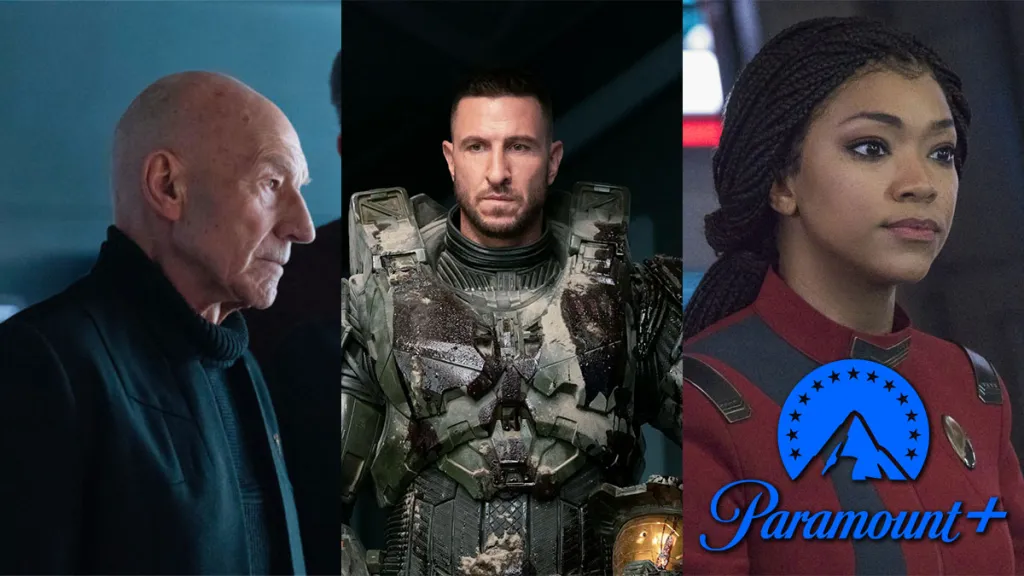
Best Paramount Plus Series & Shows to Watch Now (April 2024)
By Mofeeza Masood
Looking for the best Paramount Plus shows and series to watch in April 2024 ? Dive into sci-fi adventures with the returning Star Trek: Discovery and the debut of Halo, or explore historical fiction with A Gentleman in Moscow. This month also brings new seasons of fan favorites like Star Trek: Picard and the new legal drama Tracker. We’ve got something for everyone on your Paramount Plus must-watch list this April!
What are the best Paramount Plus series to watch in April 2024?
Stuck at home this April? No worries! Paramount+ has you covered with amazing content. Watch the best Paramount Plus series in April 2024, including new seasons and exciting debuts. We’ve got something for everyone on your streaming list this month!
A Gentleman in Moscow
Ewan McGregor takes center stage as Count Alexander Rostov, a man plucked from a life of luxury into the confines of a grand Moscow hotel room. Stripped of his title and wealth in the wake of the Russian Revolution, the Count faces an unusual sentence: lifelong house arrest within the hotel walls. But, in A Gentleman in Moscow , confinement breeds an unexpected kind of freedom. As years flow by, the once-aristocratic Count discovers a rich tapestry of life within the hotel’s microcosm. He develops unlikely friendships with a vibrant cast of characters, from hotel staff to fellow residents. Fleeting romance blossoms and the enduring power of human connection becomes the Count’s solace.
Elsbeth fits the bill for a great watch. The main character, Elsbeth Tascioni, is a brilliant lawyer with a refreshingly unconventional approach. She’s got a sharp mind and a knack for seeing things from a different angle, which helps her solve complex cases. The series also throws in an interesting twist by having Elsbeth work alongside the NYPD. She’s not your typical courtroom lawyer – she gets out in the field and works directly with detectives to crack crimes. This unique dynamic makes for a thrilling show that will keep you guessing.
Halo throws you right into a war for humanity’s survival against the Covenant, a powerful alien alliance. The show explores the characters’ motivations and backstories, not just the action. You’ll get to know Master Chief John-117, the AI companion Cortana, and other characters struggling with duty, purpose, and the nature of war. While inspired by the video games, Halo isn’t a straight adaptation. It takes creative liberties to build a new story within the Halo universe, offering a fresh perspective for fans and newcomers alike.
Star Trek: Discovery
Discovery celebrates the spirit of Gene Roddenberry’s vision with a fresh, serialized format. Michael Burnham, Discovery’s captain, is a complex and compelling lead. Brilliant and flawed, she defies expectations and pushes the boundaries of Starfleet protocols in her pursuit of what’s right. Discovery ventures beyond the familiar, exploring new corners of the galaxy and encountering never-before-seen alien species. While Discovery has thrilling space battles and exciting missions, it places a strong emphasis on character development. You’ll witness the crew grapple with personal demons, moral dilemmas, and the importance of self-discovery alongside their journeys.
Star Trek: Lower Decks
Set phasers to fun for Star Trek: Lower Decks on Paramount Plus! This hilarious animated series takes you on a wild ride with the unsung heroes of the Starship Cerritos, one of Starfleet’s least important vessels. Lower Decks cleverly combines adult humor with a deep love for Star Trek canon. Get ready for tons of Easter eggs, hilarious references, and a fresh comedic perspective on the franchise. Lower Decks shines a light on the often-overlooked support crew who keeps the starships running. It’s a hilarious and heartwarming ode to the people who make warp speed possible.
Star Trek: Picard
Star Trek: Picard picks up with Jean-Luc Picard decades after his adventures with the Enterprise crew. Retired from Starfleet and haunted by past experiences, Picard is pulled back into a new mission that will test his strength and resolve. Get ready for a wave of nostalgia! Picard reunites with some of his former crewmates from the Next Generation, including William Riker, Deanna Troi, and others. Picard isn’t just a nostalgic trip down memory lane. It promises thrilling space adventures, uncovering mysteries, and facing dangerous new threats.
Star Trek: Strange New Worlds
Strange New Worlds captures the optimism and wonder of classic Star Trek while bringing a fresh, modern visual aesthetic. Explore the familiar faces of Captain Christopher Pike, Science Officer Spock, and Number One through a new lens. See their journeys, relationships, and personalities before Kirk took the helm. Join the crew as they boldly go where no one has gone before, encountering new alien species, unfamiliar planets, and the wonders of the galaxy. Strange New Worlds embraces a more episodic format, offering self-contained stories in each episode while building character arcs and lore throughout the season.
This gripping series follows Colter Shaw, a lone-wolf survivalist with exceptional tracking skills. As a skilled reward seeker, Colter uses his talents to help both private citizens and law enforcement in solving mysteries. If you’re looking for something different from your typical detective show, Tracker delivers. The wilderness setting and Colter’s unique skillset offer a refreshing twist on the crime-solving genre.
Share article
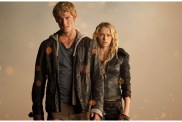
I Am Number Four Streaming: Watch & Stream Online via Hulu
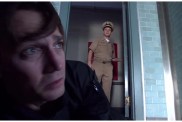
Deep Evil (2004) Streaming: Watch & Stream Online via Amazon Prime Video

Life of Brian Streaming: Watch & Stream Online via Netflix
Marvel and dc.
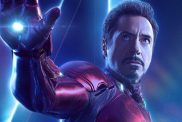
Robert Downey Jr. Reveals if He Would Return to the MCU

Daredevil: Born Again Photos Celebrate Production Wrap
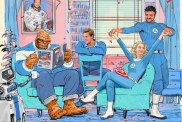
The Fantastic Four Poster Previews Joseph Quinn’s Human Torch

Comedy Central Roast of Bob Saget Streaming: Watch & Stream Online via Paramount Plus

New K-Drama Episode Releases This Week (April 8-14, 2024): Queen of Tears, Lovely Runner, Missing Crown Prince & More
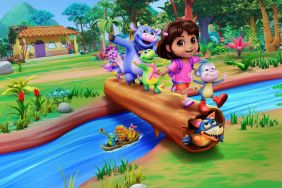
Paramount Plus Schedule April 8-14 2024: New TV Shows & Movies Being Added

Blood Free K-Drama: Everything To Know Han Hyo-Joo’s Upcoming Thriller Series

IMAGES
VIDEO
COMMENTS
aliens. Star Trek is a science fiction media franchise that began with Gene Roddenberry 's launch of the original Star Trek television series in 1966. Its success led to numerous films, novels, comics, and spinoff series. A major motif of the franchise involves encounters with various alien races throughout the galaxy.
Roylan. First appearance: Star Trek (2009) So far, the rebooted Trek films have not really given funs much by way of alien species. The only classic races to get good screen time in the reboots ...
In the TOS movies, Spock was joined by the iconic Saavik and Valeris: two of his proteges. Since then, other notable Vulcans have been integral to the adventures seen in other Star Trek series, with T'Pol in Enterprise, Tuvok in Voyager, and T'Lyn in Lower Decks. None are quite as iconic as Spock, though Tuvok probably comes closest.
Star Trek species are lifeforms featured in the fictional series Star Trek. Sentient hybrid lifeforms featured in the series should be categorized as Star Trek hybrids. Subcategories. This category has the following 7 subcategories, out of 7 total. B. Bajorans (15 P) C. Cardassians (12 P ...
Klingon. The Klingons ( / ˈklɪŋ ( ɡ) ɒn / KLING- (g)on; [2] Klingon: tlhIngan [ˈt͡ɬɪŋɑn]) are a fictional species in the science fiction franchise Star Trek . Developed by screenwriter Gene L. Coon in 1967 for the original Star Trek ( TOS) series, Klingons were swarthy humanoids characterized by prideful ruthlessness and brutality.
This category encompasses all biological species that do not qualify as artificial lifeforms or belong to Category:Animals or Category:Plants.
Star Trek is a massive property, and as a result there are subsections within the fandom that prefer different alien species of another based on what stories appeal to them. Some stories and films ...
Leonard Nimoy as Commander Spock in the Star Trek: The Original Series, broadcast Oct. 4, 1988. CBS/Getty Images. Humans are complex creatures, capable of being logical, tactical, aggressive ...
A species or race was any class of lifeform that had common attributes and were designated by a common name. According to Data, "in the game of military brinksmanship, individual physical prowess is less important than the perception of a species as a whole." However, according to Worf, if "no one is willing to test that perception in combat [..] then the reputation means nothing." (TNG: "Peak ...
5. J'Naii. Like a lot of alien races in Star Trek, the J'Naii are only physically distinguishable from humans by a series of facial ridges, in addition to a distinct lack of eyebrows and uniformly brunette hair. Culturally, they are very different, however, as they are a species that completely reject the notion of gender.
2. Horta ("Star Trek: The Original Series," 1966-1969) Paramount. This is a species of silicon-based life (humans, by comparison, are carbon-based) that prefers to feed on rocks. In a moving ...
8. The Gorn. A race of aliens both beloved by fans and deeply underrepresented within Star Trek canon itself is the Gorn. A scaly, sharp-toothed species that resemble man-sized dinosaurs, the Gorn have so far only appeared in two episodes ever, but have never been forgotten by fandom.
1 The Borg. A species of faceless, voiceless cybernetic zombies, the Borg are the most threatening villains in all of Star Trek. Introduced in the TNG season 2 episode "Q Who," the Borg assimilate entire planets and species into their collective with the explicit goal of making all of the universe Borg. After assimilating Captain Picard in the ...
Fictional species in "Star Trek" - Daily Themed Crossword. Hello everyone! Thank you visiting our website, here you will be able to find all the answers for Daily Themed Crossword Game (DTC). Daily Themed Crossword is the new wonderful word game developed by PlaySimple Games, known by his best puzzle word games on the android and apple store.
There are five distinct species of Xindi, and five distinct opinions on which one is dominant.Kessick The Xindi (pronounced "ZIN-dee") were six sentient species who evolved on the same planet in the Delphic Expanse, known as Xindus in the Milky Way Galaxy. In the early 2150s, the Xindi Council committed an infamous attack on Earth and made repeated attempts to terminate Humans, which changed ...
Tribble. Tribbles are a fictional alien species in the Star Trek universe. They were conceived by screenwriter David Gerrold and first appeared in 1967, in the fifteenth episode of the second season of Star Trek: The Original Series, titled "The Trouble with Tribbles". They are depicted as a small, furry, gentle, cute and slow-moving, but ...
The Crossword Solver found 30 answers to "Fictional species in Star Trek", 5 letters crossword clue. The Crossword Solver finds answers to classic crosswords and cryptic crossword puzzles. Enter the length or pattern for better results. Click the answer to find similar crossword clues . A clue is required.
Species 2000, 3783, and 5008 are among those species, being the Cardassians, the Romulans, and the Klingons, respectively. While the explanation of how the Borg designates numbers to a certain species seems quite straightforward, some deviations may mean there's more to the numbering system than meets the eye. Keep reading to learn all you ...
The Cardassians ( / kɑːrˈdæsiənz /) are a fictional extraterrestrial species in the American science fiction franchise Star Trek. They were devised in 1991 for the series Star Trek: The Next Generation before being used in the subsequent series Star Trek: Deep Space Nine and Star Trek: Voyager. The writers of The Next Generation introduced ...
The fact that most humanoid-looking life in Star Trek descended from an ancient alien species isn't a new revelation to longtime Trek fans. Even Original Series episodes "Return to Tomorrow ...
Star Trek features some of the most iconic alien species in all of science fiction, and those species are often defined by one particularly noteworthy character. Since the earliest days of Star Trek: The Original Series, part of Starfleet's mission has been to seek out new life in the galaxy in an attempt to learn and better understand both alien and human life.
Michelle Yeoh just wrapped filming the first "Star Trek" TV movie, "Section 31," a spy thriller that the Oscar winner characterizes as "'Mission: Impossible' in space.". And this ...
The Ferengi ( / fəˈrɛŋɡi /) are a fictional extraterrestrial species in the American science fiction franchise Star Trek. They were devised in 1987 for the series Star Trek: The Next Generation, played a prominent role in the following series Star Trek: Deep Space Nine, and have made brief appearances in subsequent series such as Star Trek ...
Star Trek is known for some of the most famous alien races in all of science fiction. ... But the series also includes some of the most famous alien races in all of science fiction: species and ...
In late 1999, the greatest homage to Star Trek hit theaters in the form of Galaxy Quest. Taking place 14 years after a hit sci-fi series went off the air, we watched as the Trek universe and ...
Within the pages of the latest issue of Star Trek Explorer, dive into a handful of exclusive fiction, interviews, and features. Star Trek Explorer #11 celebrates the final season of Star Trek: Discovery with an exclusive interview with Sonequa Martin-Green. She teases things to come as the series draws to a close, and offers some candid comments on what she hopes the legacy of the show will be.
Callum Keith Rennie joins Star Trek: Discovery season 5 as Captain Rayner, the fierce commander of the USS Antares.Driven and dedicated to his mission, Rayner draws distinction between himself and his crew. A member of a little-known species first introduced in Star Trek: Deep Space Nine, Captain Rayner is a Kellerun, and his backstory is crucial to his mission and character.
Looking for the best Paramount Plus shows and series to watch in April 2024?Dive into sci-fi adventures with the returning Star Trek: Discovery and the debut of Halo, or explore historical fiction ...
Godzilla films. Three-headed dragon. Kineceleran. Ben 10. Armored velociraptor -like humanoids from the stormy planet Kinet, Kinecelerans have extraordinary speed, able to accelerate to 500 miles per hour in a second. They can use their speed to generate twisters and also have prehensile tails and sharp claws. Kisshu. Tokyo Mew Mew.